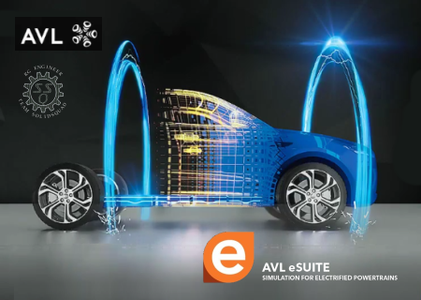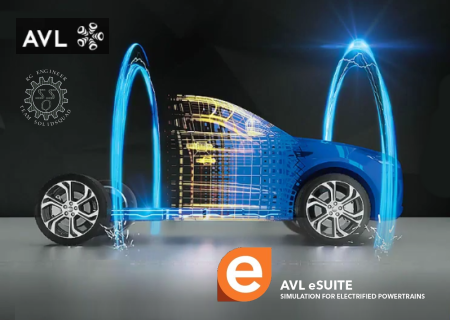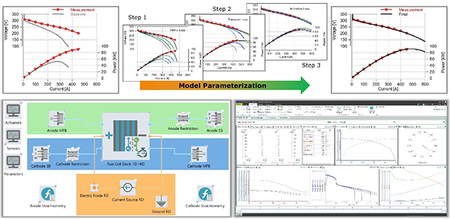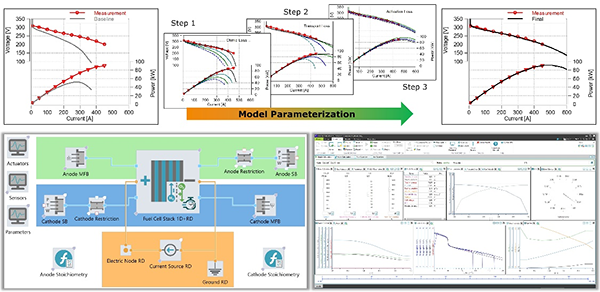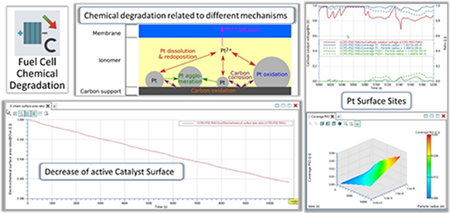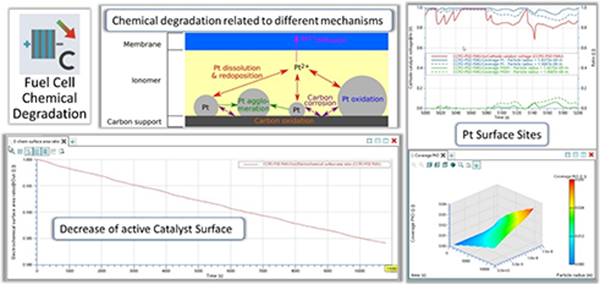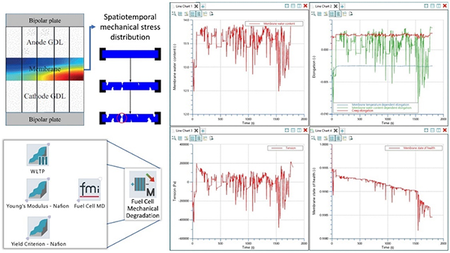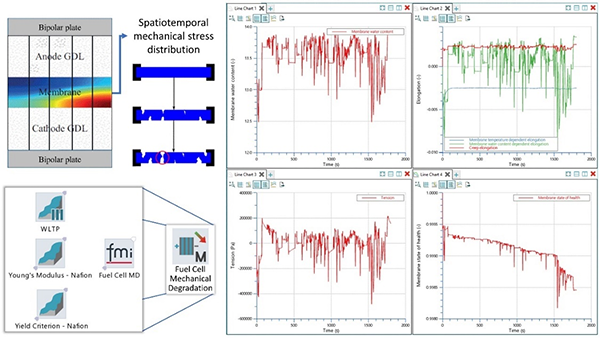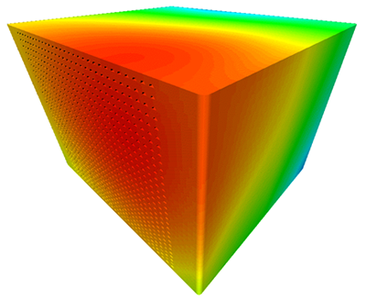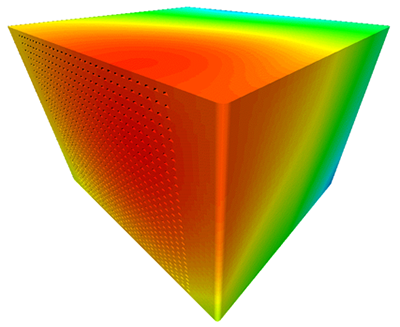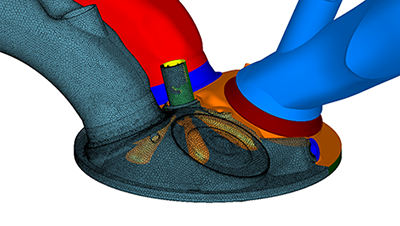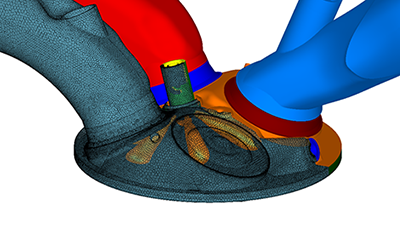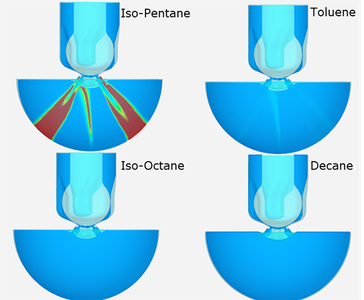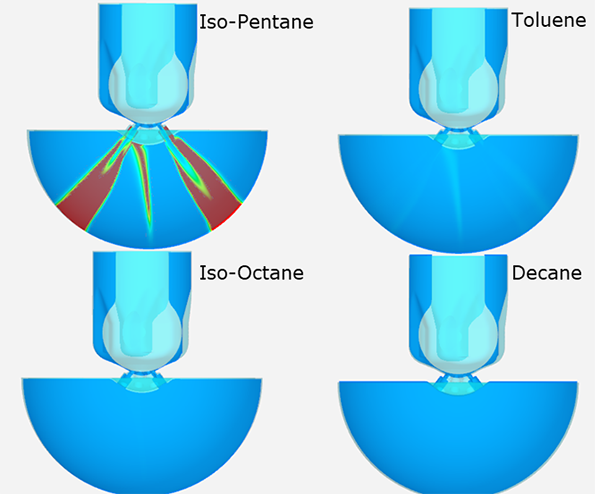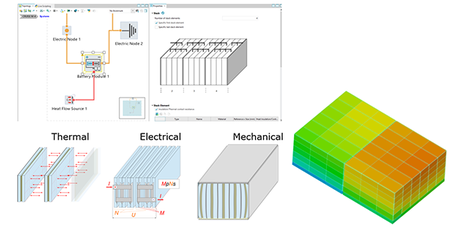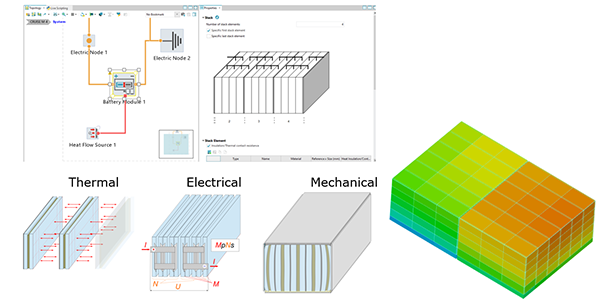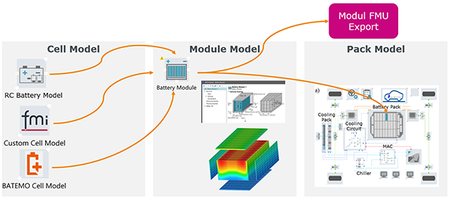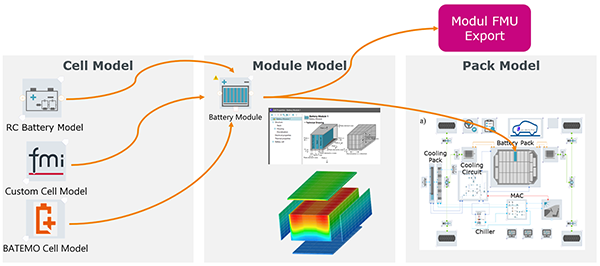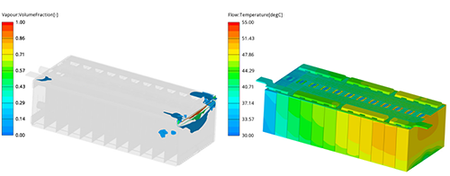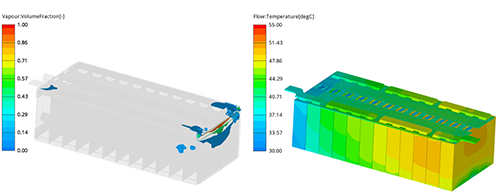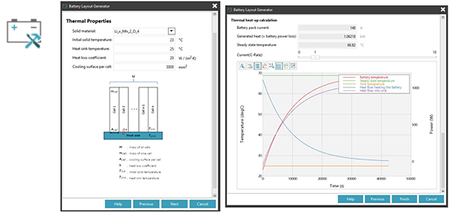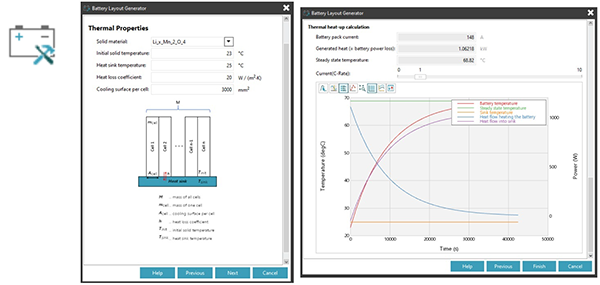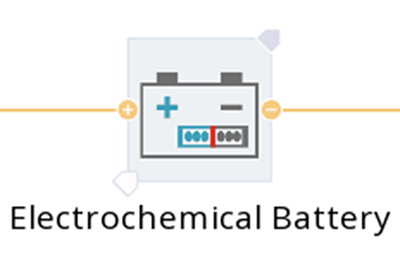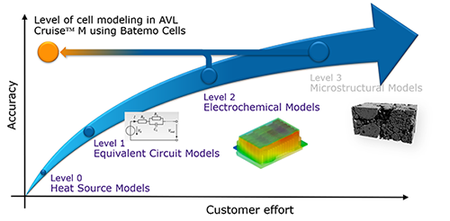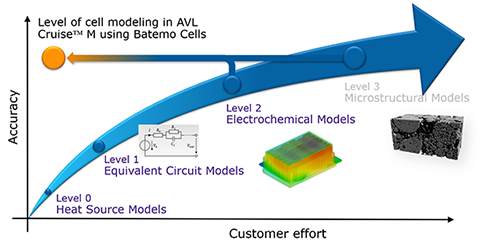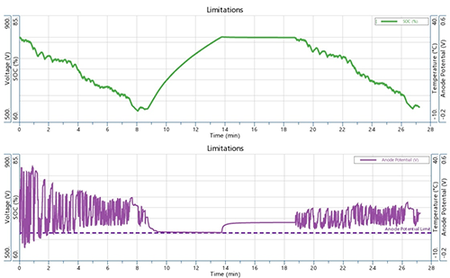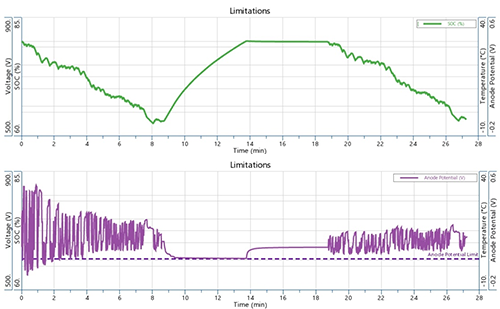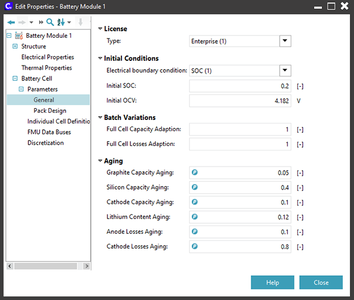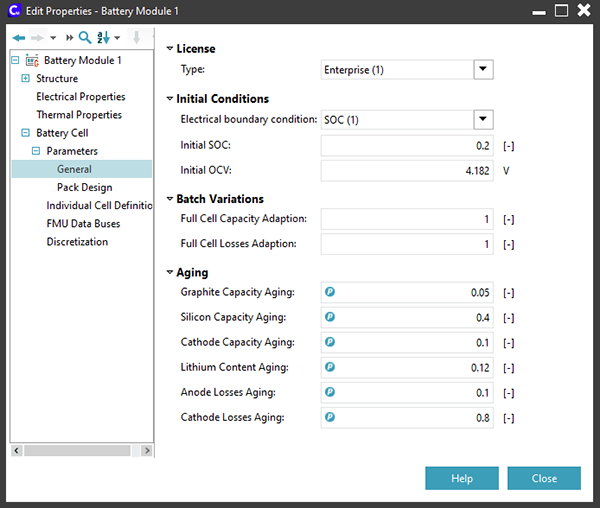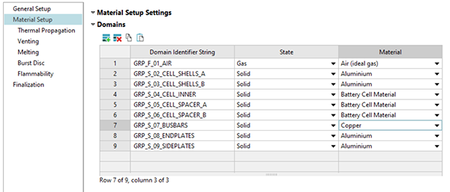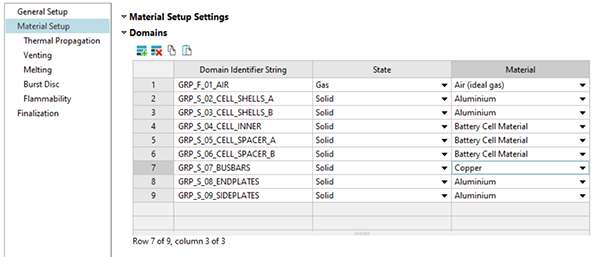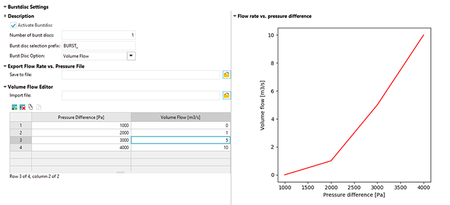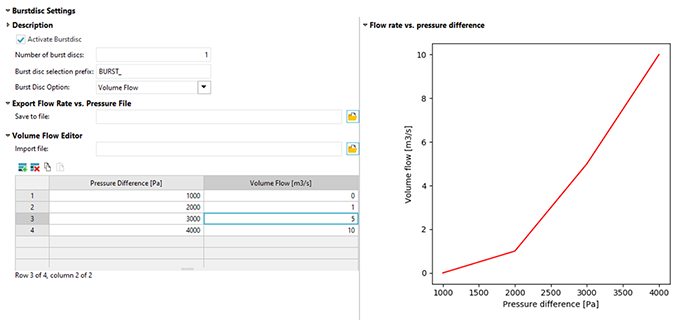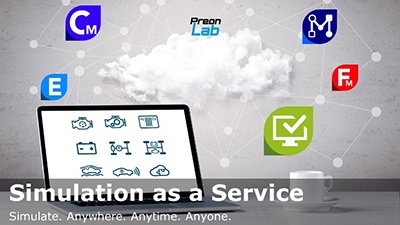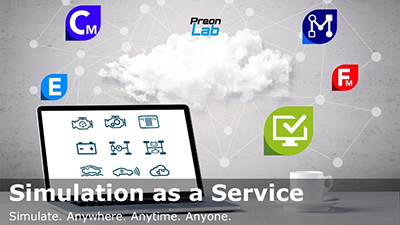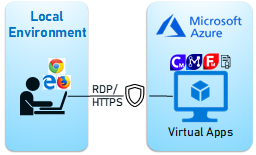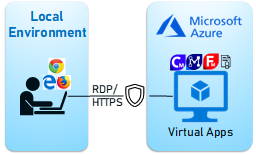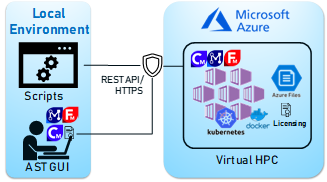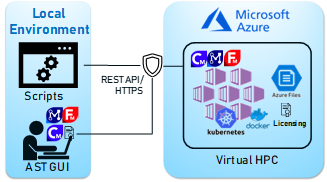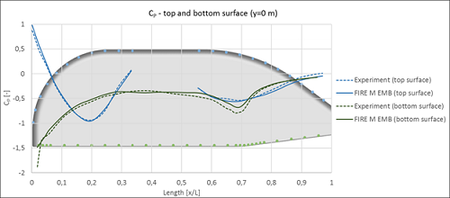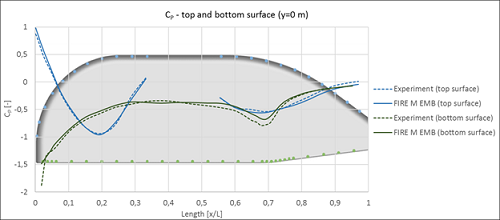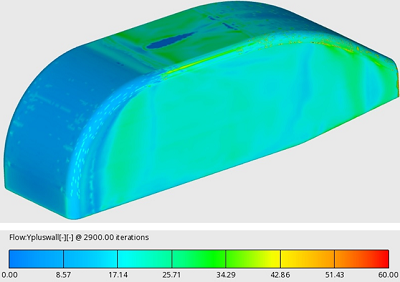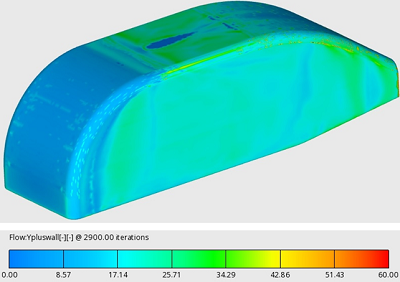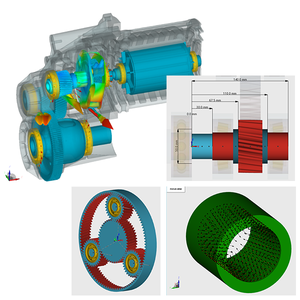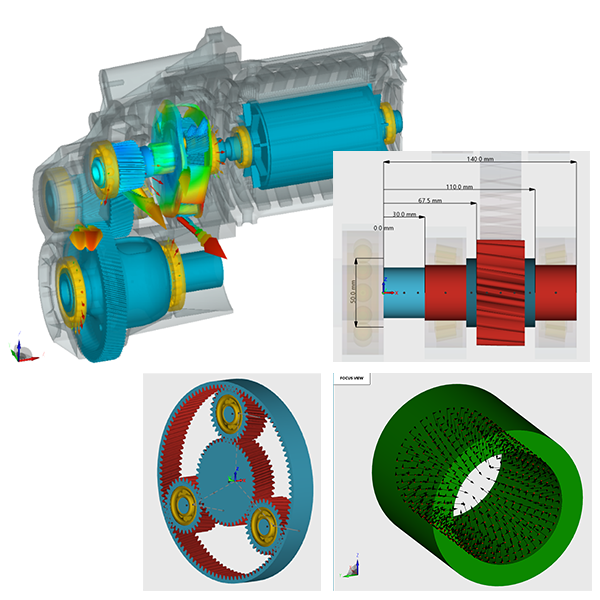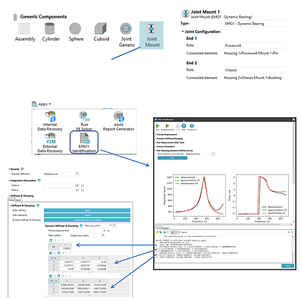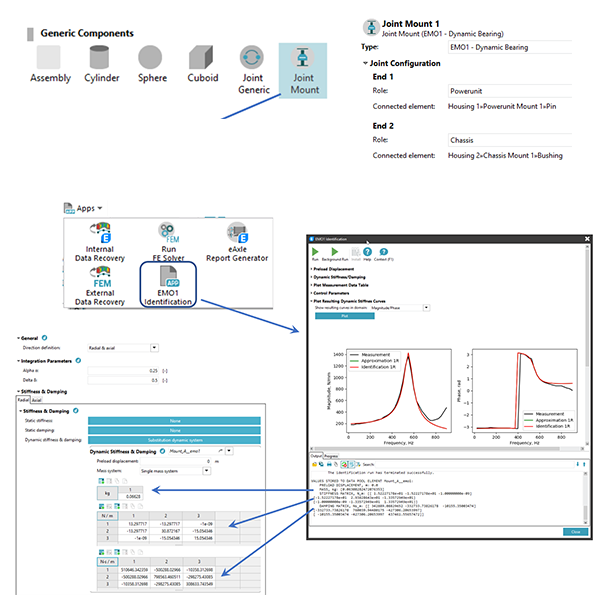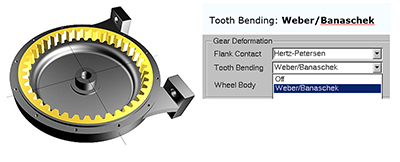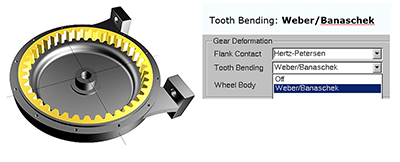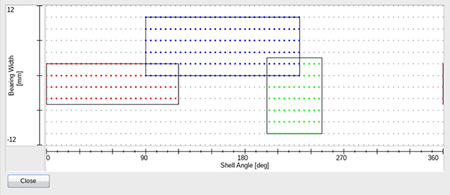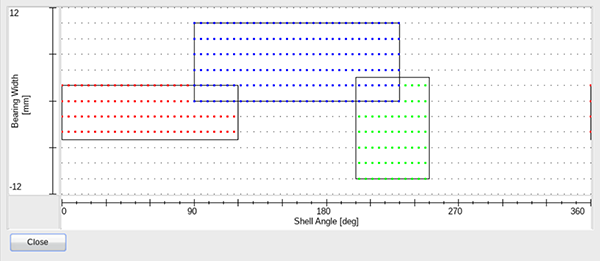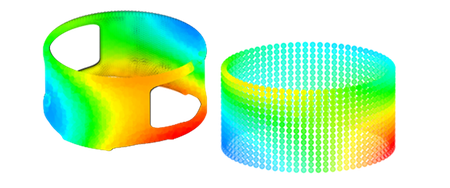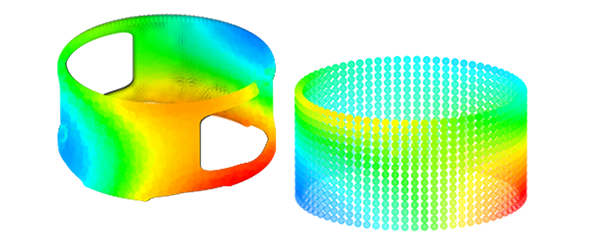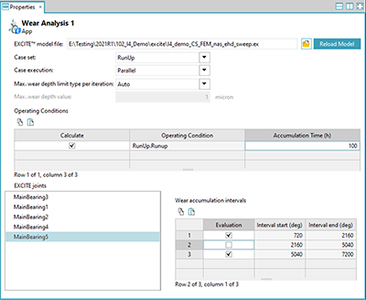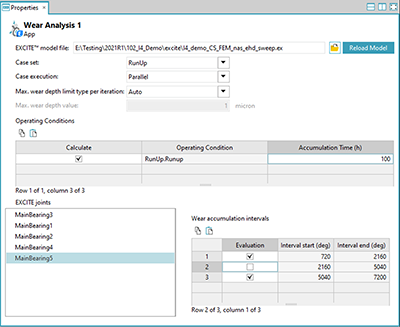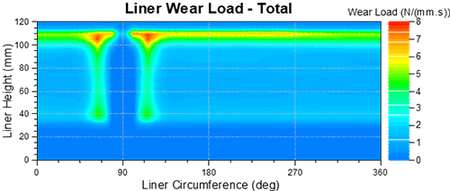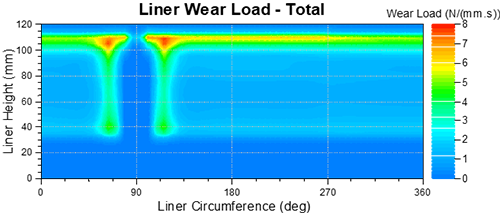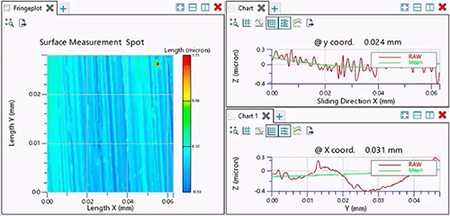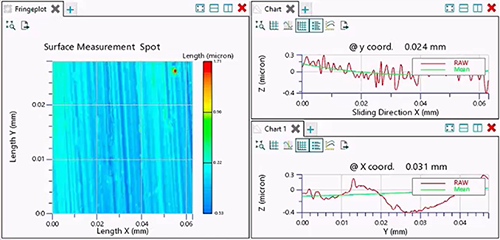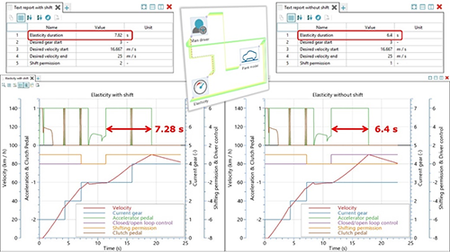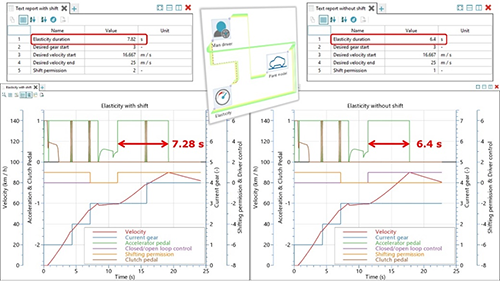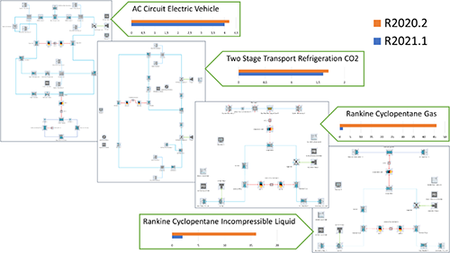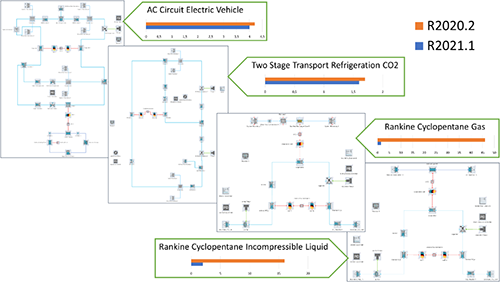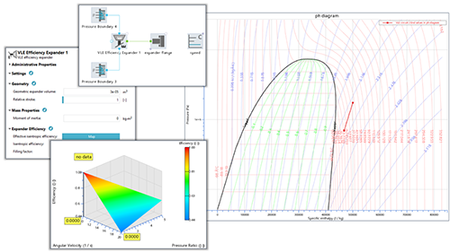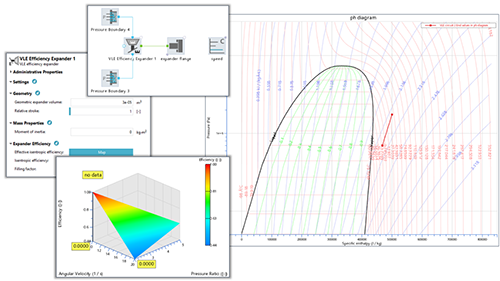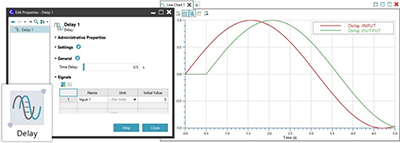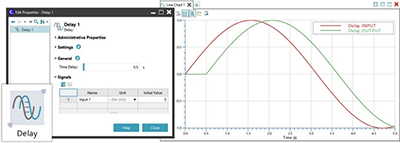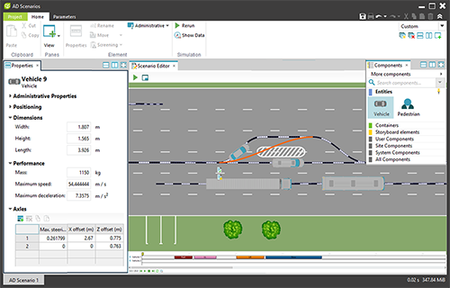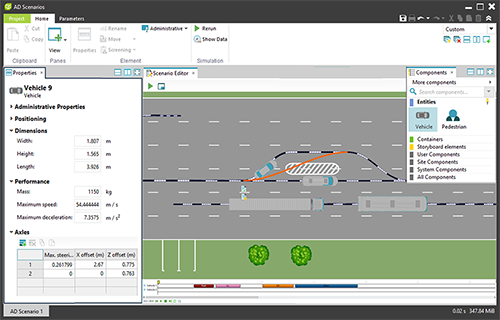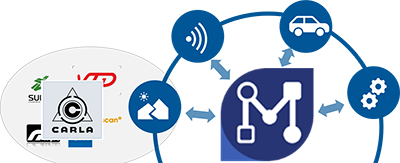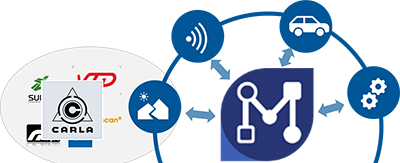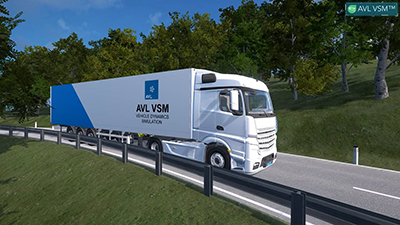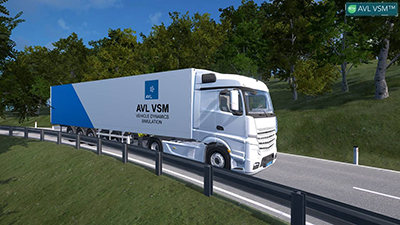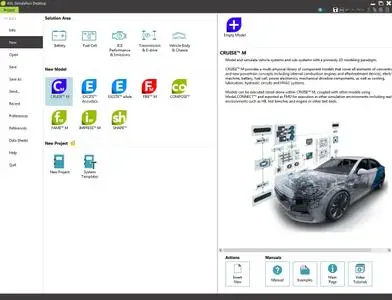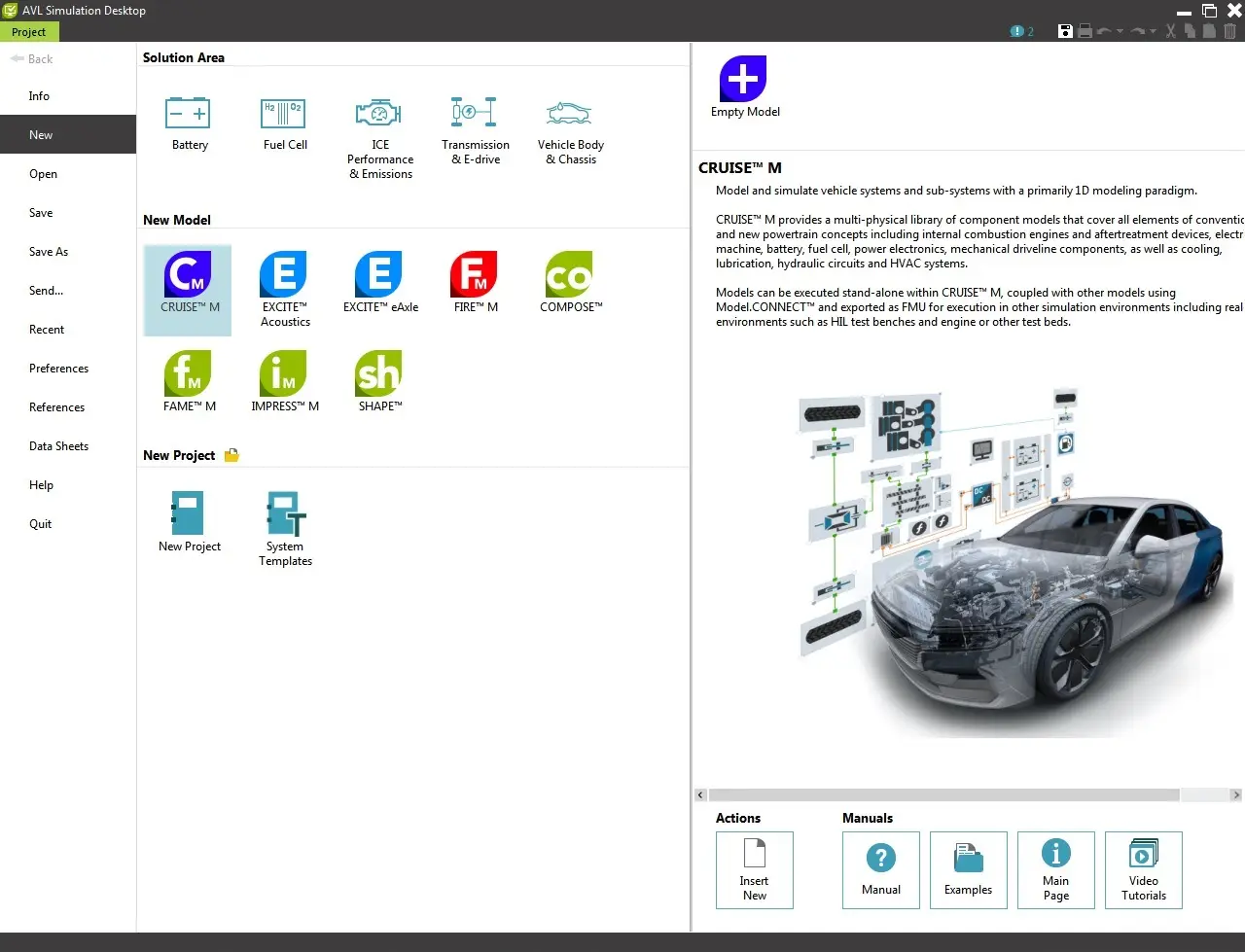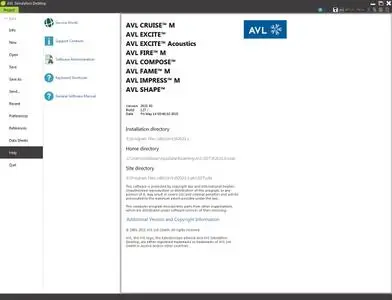AVL eSuite 2021 R1 | 13.9 Gb
The software developer AVL is pleased to announce the availability of AVL eSUITE 2021 R1 is a comprehensive solution that covers all aspects of powertrain concept, the e-motor, e-axle, power electronics, fuel cell, battery and control functions layout and integration.
Release 2021 R1
We are pleased to announce the latest software releases for the following solutions:
The latest release of AVL’s Virtual Fuel Cell Development Solution – 2021R1 – includes various new features and functionalities for fuel cell analysis at system and component level. The following release note provides a short summary of the main highlights of this release. More specific details can be found in the product release notes of AVL CRUISE M and AVL FIRE M.
PEM Fuel Cell System Layout and Integration
Reduced Dimensionality PEMFC Model
The latest version of CRUISE M includes a new electrochemical model for proton exchange membrane fuel cell (PEMFC) simulation. The model covers the relevant physical domains of the stack and their interactions. This includes, for example, anode and cathode gas flow, electric network, and thermal network, as well as the electrochemical and transport processes in the membrane electrode assembly (MEA). With regards to channel flow direction, the domains are discretized in 1D while the MEA-related electrochemical and transport models feature a reduced dimensionality approach. The latter offers an optimum compromise between modeling depth and computational performance, with the underlying models ensuring full consistency in consideration of thermodynamics and electrochemistry.
The Reduced Dimensionality PEMFC Model consistently correlates cell performance with reactant concentrations, temperature, water content and current, and thus holds all essential causal relations. In terms of cell performance prediction, optional models can be applied for channel pressure drop evaluation, nitrogen cross-diffusion and membrane wetting.
Chemical Degradation Model
The new release of CRUISE M introduces a model for chemical degradation in PEM fuel cells. This model describes, depending of the fuel cell state, unwanted aging phenomena taking place mainly in the catalyst layer next to the membrane. This involves carbon corrosion, platinum oxidation, platinum redistribution and diffusion of platinum ions. The platinum particle size redistribution model considers – for a given number of discrete particle classes – particle detachment, attachment, Ostwald ripening and agglomeration.
The Chemical Degradation Model can be linked to the different fuel cell models from the CRUISE M library, with custom fuel cell models or even testbed data. The degradation model is ready to run straight from the component library, with the data bus connections, membrane properties, initial conditions and a series of reaction parameters seamlessly adaptable according to the user’s needs.
Mechanical Degradation Model
This release of CRUISE M also offers a model for the mechanical degradation of PEM fuel cells. The model describes the tension and deformation energy in the membrane. It considers changes of water content and temperature, as well as creep elongation due to clamping pressure. The basis for this approach is the Eyring model for viscous materials. It has been extended by including thermal and creep effects.
This whole degradation model is provided as standalone functionality. This enables it to be linked with the different fuel cell models from the CRUISE M library, with custom fuel cell models or even with testbed data.
The Mechanical Degradation Model is ready to run straight from the component library with example data from a WLTC cycle and tabulated material properties. Simulation engineers can easily adapt the cycle-related input data and material properties according to their modeling needs and modify maximum deformation pressure and actual clamping forces. The degradation model returns a series of results for detailed analysis and the fulfillment of the yield criterium and membrane state of health.
PEM Fuel Cell and Stack Multiphysics Analysis
Solid Oxide Fuel Cell and Solid Oxide Electrolyzer Cell
Solid Oxide Fuel Cell (SOFC) systems allow different non-hydrocarbon and hydrocarbon fuels to be used for highly efficient conversion from chemical energy to electricity. These are ideal for both automotive and non-automotive applications. The combination of fuel cell technology with Solid Oxide Electrolyzer (SOEC) systems for energy buffering is an attractive alternative to conventional technologies for flattening fluctuating electricity production.
The required operating temperatures between 600°C and 900°C impose a number of challenges regarding thermal behavior of SOFC and SOEC components (e.g. cell, interconnect, sealing). Of particular interest is the thermal loading of the stack during transient operation and heat-up.
To support the development and optimization of SOFC and SOEC at single cell and stack level, we have also extended the fuel cell module of AVL FIRE™ M to fully support the simulation of the transient multi-physics phenomena that govern component performance and thermal behavior.
The related simulation features and capabilities cover the broad variety of relevant physical phenomena, such as multi-component convective and diffusive mass transfer, heat transfer and electrochemistry, as well as internal hydrocarbon reforming and co-electrolysis. Chemical reactions in the negative electrode domain, hydrocarbon steam reforming and water gas shift reaction are now fully accounted for. Furthermore, the Property Database covers the new SOFC and SOEC-related material groups and additional materials.
The new model features and capabilities can be used to simulate both individual planar and tubular SOFC and SOEC cells as well as complete stacks. Steady state and transient simulations are fully supported. This includes simulations such as different load cycles and transient heat up processes.
PEM Fuel Cell System Layout and Integration
Reduced Dimensionality PEMFC Model
The latest version of CRUISE M includes a new electrochemical model for proton exchange membrane fuel cell (PEMFC) simulation. The model covers the relevant physical domains of the stack and their interactions. This includes, for example, anode and cathode gas flow, electric network, and thermal network, as well as the electrochemical and transport processes in the membrane electrode assembly (MEA). With regards to channel flow direction, the domains are discretized in 1D while the MEA-related electrochemical and transport models feature a reduced dimensionality approach. The latter offers an optimum compromise between modeling depth and computational performance, with the underlying models ensuring full consistency in consideration of thermodynamics and electrochemistry.
The Reduced Dimensionality PEMFC Model consistently correlates cell performance with reactant concentrations, temperature, water content and current, and thus holds all essential causal relations. In terms of cell performance prediction, optional models can be applied for channel pressure drop evaluation, nitrogen cross-diffusion and membrane wetting.
Chemical Degradation Model
The new release of CRUISE M introduces a model for chemical degradation in PEM fuel cells. This model describes, depending of the fuel cell state, unwanted aging phenomena taking place mainly in the catalyst layer next to the membrane. This involves carbon corrosion, platinum oxidation, platinum redistribution and diffusion of platinum ions. The platinum particle size redistribution model considers – for a given number of discrete particle classes – particle detachment, attachment, Ostwald ripening and agglomeration.
The Chemical Degradation Model can be linked to the different fuel cell models from the CRUISE M library, with custom fuel cell models or even testbed data. The degradation model is ready to run straight from the component library, with the data bus connections, membrane properties, initial conditions and a series of reaction parameters seamlessly adaptable according to the user’s needs.
Mechanical Degradation Model
This release of CRUISE M also offers a model for the mechanical degradation of PEM fuel cells. The model describes the tension and deformation energy in the membrane. It considers changes of water content and temperature, as well as creep elongation due to clamping pressure. The basis for this approach is the Eyring model for viscous materials. It has been extended by including thermal and creep effects.
This whole degradation model is provided as standalone functionality. This enables it to be linked with the different fuel cell models from the CRUISE M library, with custom fuel cell models or even with testbed data.
The Mechanical Degradation Model is ready to run straight from the component library with example data from a WLTC cycle and tabulated material properties. Simulation engineers can easily adapt the cycle-related input data and material properties according to their modeling needs and modify maximum deformation pressure and actual clamping forces. The degradation model returns a series of results for detailed analysis and the fulfillment of the yield criterium and membrane state of health.
PEM Fuel Cell and Stack Multiphysics Analysis
Solid Oxide Fuel Cell and Solid Oxide Electrolyzer Cell
Solid Oxide Fuel Cell (SOFC) systems allow different non-hydrocarbon and hydrocarbon fuels to be used for highly efficient conversion from chemical energy to electricity. These are ideal for both automotive and non-automotive applications. The combination of fuel cell technology with Solid Oxide Electrolyzer (SOEC) systems for energy buffering is an attractive alternative to conventional technologies for flattening fluctuating electricity production.
The required operating temperatures between 600°C and 900°C impose a number of challenges regarding thermal behavior of SOFC and SOEC components (e.g. cell, interconnect, sealing). Of particular interest is the thermal loading of the stack during transient operation and heat-up.
To support the development and optimization of SOFC and SOEC at single cell and stack level, we have also extended the fuel cell module of AVL FIRE™ M to fully support the simulation of the transient multi-physics phenomena that govern component performance and thermal behavior.
The related simulation features and capabilities cover the broad variety of relevant physical phenomena, such as multi-component convective and diffusive mass transfer, heat transfer and electrochemistry, as well as internal hydrocarbon reforming and co-electrolysis. Chemical reactions in the negative electrode domain, hydrocarbon steam reforming and water gas shift reaction are now fully accounted for. Furthermore, the Property Database covers the new SOFC and SOEC-related material groups and additional materials.
The new model features and capabilities can be used to simulate both individual planar and tubular SOFC and SOEC cells as well as complete stacks. Steady state and transient simulations are fully supported. This includes simulations such as different load cycles and transient heat up processes.
The latest release of AVL’s ICE Performance and Emissions Simulation solution – version 2021R1 – includes a range of enhancements that bring a variety of new benefits to its users.
The highlights in 2021R1 include:
System Simulation, AVL CRUISE M
- Engine Parameter Wizard and Engine Model Generator extensions
- Soft ECU model setup
- New generation of Turbocharger Parameterization Wizard
- Crank angle-resolved Engineering-Enhanced Gasoline Cylinder
- Enhancements of the exhaust gas aftertreatment solution
Component Simulation, AVL FIRE M
- IC Engine Simulation Solution in FIRE M
- FIRE M Engine
- FIRE M Engine project template
- FIRE M Engine pre-processing enhancements
- Injector flow simulation, involving multi-component fuels
Component Simulation, AVL FIRE
- Upgrades of physical and chemical modelling capabilities
System Simulation with CRUISE M
Engine Parameter Wizard and Engine Model Generator Extensions
Engine Parameterization Wizard:
- For engineering enhanced gasoline models, closed loop throttle control components have now been added to the throttle subsystem
- Additional (unconnected) ECU maps are provided, which can be used for control
- Standard sensor names for IMEP and NOx have been changed to ensure consistency with the Data Monitor in the Operations Mode subsystem
- EPW models now use absolute humidity vales that are automatically connected to the gas composition
Engine Parameterization Wizard and Engine Model Generator
- The exhaust aftertreatment system (catalyst) is now represented by a generic transfer component.
Soft-ECU Model Setup
With this release the Engine Parametrization Wizard is extended to setup models th at include soft-ECU functionalities.
This is realized by the creation of a cascade of maps which are derived from steady-state measurement data. A base map holds the dependency of torque demand, based on two leading operating parameters – speed and accelerator pedal position. Engine speed and torque demand further feed into a list of separate maps. These take care of turbine VTG (or waste gate) positions, EGR valve operation, injection timings (pilot, main and post injections), rail pressure and exhaust and swirl flap position, if available. The model is then finally ready to be used as a self-contained and well-encapsulated block within the vehicle system simulation, making it easy for vehicle engineers to deal with it.
New Generation of Turbocharger Parameterization Wizard
The Turbocharger Parameterization Wizard released with CRUISE M 2021 R1 has been upgraded with a new workflow.
The system guides the simulation engineer through several steps of map consistency checks, compressor mass flow correction, speed correction, etc. up to a final quality cross check with an unconstrained running turbocharger. Each single step automatically proposes an optimized solution of the applied corrections. The proposal can be inspected and, if needed, manually modified. At the end of the process the model topology of the turbocharger is automatically generated.
Crank Angle-Resolved Engineering Enhanced Gasoline Cylinder
In addition to the well-known and proven mean-value-based cylinder model (EEGC), CRUISE M 2021R1 also introduces a crank-angle resolved cylinder model (CAR). This aims to ensure that the link to the classic crank-angle resolved 1D thermodynamic simulation is tight, while also providing real-time capable computational performance. The reuse of established models for gas exchange and combustion enables a seamless crossing from office to HiL simulation.
This new version of CRUISE M combines the best of both approaches. The combustion and emission models from the EEGC are incorporated into the CAR cylinder framework that contributes its physics-based gas exchange and 0D thermodynamics approaches.
Enhancements of the Exhaust Gas Aftertreatment Solution
Improved coupling of engine and aftertreatment model:
In CRUISE M 2021R1 the co-simulation delay between engine thermodynamics, which typically runs with time steps of 1 ms, and the aftertreatment system, which usually applies time steps of around 100 ms, has been improved. This helps to capture, for example, the dynamic effects of low pressure EGR configurations where the dynamics downstream the aftertreatment system need to have the same frequency as in the intake system.
Improved particulate filter performance:
Robust and real time-capable simulation of exhaust gas aftertreatment systems is one of the central features of CRUISE Aftertreatment. Benchmark examples, comparing the newly implemented speed up measured with the previous status showed a speed up of up to 70 %. On average a real-time factor of below 0.1 can be observed.
New particulate filter filtration model:
This version of CRUISE M offers a refined filtration model that considers the microstructure of the porous filter wall.
Other important enhancements include:
- Update of standard exhaust aftertreatment system components to reflect the latest developments
- New catalyst and insulation materials have been added to the material database
- For improved layout flexibility, additional pipes and electrically heated catalysts have been added
Component Simulation in FIRE M
IC Engine Simulation Solution in FIRE M
FIRE M 202R2 offered automated pre- and postprocessing capabilities for IC engines. The new release takes this further, with the ability to execute in-cylinder flow, fuel injection, combustion and emission simulations all together.
The following capabilities are now available:
- Fuel (and other fluids) property data is available as part of the Property Database (PDB) in the AVL Simulation Desktop
- Lagrangian spray models for all IC engine-related applications (as well as for modelling SCR systems) are included
- Wallfilm modelling is now possible
- Spark and auto-ignition modelling, including AVL’s advanced CADIM model is now possible
- Combustion model ECFM-3Z has been extended to account for multiple fuel components
- Knock event modelling based on tabulated chemistry is now possible
The solution is deployable in a multi-domain model and, if desired, with individual setups for each domain. This enables users to set up simulations for spark and auto-ignition IC engine simulations that are based on ECFM-3Z or General Gas Phase Reactions. This is achieved by harnessing the full power of FIRE M and the Simulation Desktop Framework – namely by using parametrized simulation models, enhanced scripting capabilities and flexible simulation case administration.
While making all IC engine related modules available with FIRE M R2021.1, a consistent focus has been on the multi-component fuel capabilities both for liquid and gaseous fuels. This leads to a straightforward setup and analysis of multi-component and multi-fuel simulation cases.
FIRE M Engine
To support the efficient modelling, simulation and analysis of IC engines, 2021R1 now offers the complete FIRE M Engine solution. This consists of:
- Input data provision to IC engine models via Project Data Sheet
- Fully automated part recognition and selection assignment
- Fully automated polyhedron-based computational domain discretization
- Simulation setup based on parametrizable steering files
- Variation of parameterized models for case studies and optimization
- ICE-specific report generation
FIRE M Engine Project template
FIRE M Engine is accessed via a fully automated project template. Taking advantage of Simulation Desktop Features, the IC Engine Project template bundles preprocessing, simulation execution and postprocessing into a single project. The IC Engine Project template is used to fully define a simulation task based merely on a data sheet containing:
- Global engine data, such as bore, stroke, connecting rod length
- Geometrical information, such as injector location, orientation and spray pattern
- Load point specific information on boundary temperatures, inlet/outlet conditions, ignition timing, fuel injected
- Geometry of intake and exhaust port, cylinder and valves
All the model settings needed to perform a stable and meaningful simulation based on the inputs are pre-defined or derived from the input data. The simulation model that is generated is consistent, unambiguous and contains all output for a comprehensive analysis. The simulation model can be configured to:
- Reflect multi-component liquid and gaseous fuels
- Consider multiple injections
This enables non-expert CFD analysts to perform high-fidelity IC engine simulations and case studies. Fully automated execution is supported, even when submitting jobs to a cluster by means of a queuing system.
Expert users can take advantage of the ability to individually access and adapt the building blocks of the FIRE M Engine workflow. This is possible because the workflow also can be executed step by step, with each step connected to the next one through a dedicated interface.
The IC Engine Project template is a comprehensive solution that guides the user through the process of modelling, simulating and analyzing IC engine in-cylinder flows in the highest quality possible.
FIRE M Engine – Providing efficient modelling, accurate simulation and task-specific Key Performance Indicators (KPI)
FIRE M Engine Pre-processing Enhancements 2021R1
The IC engine preprocessing solution introduced with FIRE M 2020R2, has been upgraded with the addition of:
- Enhancements to the stability of the parts detection algorithm
- A preview option for the piston displacement function
- An option to visualize all valve lift curves (and, optionally, the piston displacement function)
- The possibility to employ user-defined piston motion curves
Injector Flow Simulation Involving Multi-Component Fuels
FIRE M 2021R1 contains multiple enhancements that make it much easier, faster and more straightforward to performing nozzle flow simulations with multi-component fuels. When the solution was being developed and integrated, close attention was paid to flash boiling in engines with gasoline direct injection.
The methodology that is applied is based first upon the computing of nozzle flow in the GDI injector, using the implemented flash boiling multi-component models. During this computation, the multi-component flow variables at the nozzle hole outlets are recorded at user-defined time-intervals. They are then written into so-called “Nozzle Files.”
The multi-component “Nozzle Files” are the used as input into the multi-component in-cylinder spray, wall film, combustion and emission simulation.
Flash boiling during injection of a four-component gasoline surrogate fuel.
Component Simulation in FIRE
Upgrades of physical and chemical modelling capabilities include:
- TABKIN FGM has been coupled with the FIRE Eulerian Flame Tracking Model
- General Gas Phase Reactions have been coupled with the FIRE Eulerian Flame Tracking Model
- A new Flame / Wall Interaction Model has been linked to the ECFM-3Z model
- An update of the FGM-based knock model now includes eMAPO calculation
The highlights in 2021R1 include:
System Simulation, AVL CRUISE M
- Engine Parameter Wizard and Engine Model Generator extensions
- Soft ECU model setup
- New generation of Turbocharger Parameterization Wizard
- Crank angle-resolved Engineering-Enhanced Gasoline Cylinder
- Enhancements of the exhaust gas aftertreatment solution
Component Simulation, AVL FIRE M
- IC Engine Simulation Solution in FIRE M
- FIRE M Engine
- FIRE M Engine project template
- FIRE M Engine pre-processing enhancements
- Injector flow simulation, involving multi-component fuels
Component Simulation, AVL FIRE
- Upgrades of physical and chemical modelling capabilities
System Simulation with CRUISE M
Engine Parameter Wizard and Engine Model Generator Extensions
Engine Parameterization Wizard:
- For engineering enhanced gasoline models, closed loop throttle control components have now been added to the throttle subsystem
- Additional (unconnected) ECU maps are provided, which can be used for control
- Standard sensor names for IMEP and NOx have been changed to ensure consistency with the Data Monitor in the Operations Mode subsystem
- EPW models now use absolute humidity vales that are automatically connected to the gas composition
Engine Parameterization Wizard and Engine Model Generator
- The exhaust aftertreatment system (catalyst) is now represented by a generic transfer component.
Soft-ECU Model Setup
With this release the Engine Parametrization Wizard is extended to setup models th at include soft-ECU functionalities.
This is realized by the creation of a cascade of maps which are derived from steady-state measurement data. A base map holds the dependency of torque demand, based on two leading operating parameters – speed and accelerator pedal position. Engine speed and torque demand further feed into a list of separate maps. These take care of turbine VTG (or waste gate) positions, EGR valve operation, injection timings (pilot, main and post injections), rail pressure and exhaust and swirl flap position, if available. The model is then finally ready to be used as a self-contained and well-encapsulated block within the vehicle system simulation, making it easy for vehicle engineers to deal with it.
New Generation of Turbocharger Parameterization Wizard
The Turbocharger Parameterization Wizard released with CRUISE M 2021 R1 has been upgraded with a new workflow.
The system guides the simulation engineer through several steps of map consistency checks, compressor mass flow correction, speed correction, etc. up to a final quality cross check with an unconstrained running turbocharger. Each single step automatically proposes an optimized solution of the applied corrections. The proposal can be inspected and, if needed, manually modified. At the end of the process the model topology of the turbocharger is automatically generated.
Crank Angle-Resolved Engineering Enhanced Gasoline Cylinder
In addition to the well-known and proven mean-value-based cylinder model (EEGC), CRUISE M 2021R1 also introduces a crank-angle resolved cylinder model (CAR). This aims to ensure that the link to the classic crank-angle resolved 1D thermodynamic simulation is tight, while also providing real-time capable computational performance. The reuse of established models for gas exchange and combustion enables a seamless crossing from office to HiL simulation.
This new version of CRUISE M combines the best of both approaches. The combustion and emission models from the EEGC are incorporated into the CAR cylinder framework that contributes its physics-based gas exchange and 0D thermodynamics approaches.
Enhancements of the Exhaust Gas Aftertreatment Solution
Improved coupling of engine and aftertreatment model:
In CRUISE M 2021R1 the co-simulation delay between engine thermodynamics, which typically runs with time steps of 1 ms, and the aftertreatment system, which usually applies time steps of around 100 ms, has been improved. This helps to capture, for example, the dynamic effects of low pressure EGR configurations where the dynamics downstream the aftertreatment system need to have the same frequency as in the intake system.
Improved particulate filter performance:
Robust and real time-capable simulation of exhaust gas aftertreatment systems is one of the central features of CRUISE Aftertreatment. Benchmark examples, comparing the newly implemented speed up measured with the previous status showed a speed up of up to 70 %. On average a real-time factor of below 0.1 can be observed.
New particulate filter filtration model:
This version of CRUISE M offers a refined filtration model that considers the microstructure of the porous filter wall.
Other important enhancements include:
- Update of standard exhaust aftertreatment system components to reflect the latest developments
- New catalyst and insulation materials have been added to the material database
- For improved layout flexibility, additional pipes and electrically heated catalysts have been added
Component Simulation in FIRE M
IC Engine Simulation Solution in FIRE M
FIRE M 202R2 offered automated pre- and postprocessing capabilities for IC engines. The new release takes this further, with the ability to execute in-cylinder flow, fuel injection, combustion and emission simulations all together.
The following capabilities are now available:
- Fuel (and other fluids) property data is available as part of the Property Database (PDB) in the AVL Simulation Desktop
- Lagrangian spray models for all IC engine-related applications (as well as for modelling SCR systems) are included
- Wallfilm modelling is now possible
- Spark and auto-ignition modelling, including AVL’s advanced CADIM model is now possible
- Combustion model ECFM-3Z has been extended to account for multiple fuel components
- Knock event modelling based on tabulated chemistry is now possible
The solution is deployable in a multi-domain model and, if desired, with individual setups for each domain. This enables users to set up simulations for spark and auto-ignition IC engine simulations that are based on ECFM-3Z or General Gas Phase Reactions. This is achieved by harnessing the full power of FIRE M and the Simulation Desktop Framework – namely by using parametrized simulation models, enhanced scripting capabilities and flexible simulation case administration.
While making all IC engine related modules available with FIRE M R2021.1, a consistent focus has been on the multi-component fuel capabilities both for liquid and gaseous fuels. This leads to a straightforward setup and analysis of multi-component and multi-fuel simulation cases.
FIRE M Engine
To support the efficient modelling, simulation and analysis of IC engines, 2021R1 now offers the complete FIRE M Engine solution. This consists of:
- Input data provision to IC engine models via Project Data Sheet
- Fully automated part recognition and selection assignment
- Fully automated polyhedron-based computational domain discretization
- Simulation setup based on parametrizable steering files
- Variation of parameterized models for case studies and optimization
- ICE-specific report generation
FIRE M Engine Project template
FIRE M Engine is accessed via a fully automated project template. Taking advantage of Simulation Desktop Features, the IC Engine Project template bundles preprocessing, simulation execution and postprocessing into a single project. The IC Engine Project template is used to fully define a simulation task based merely on a data sheet containing:
- Global engine data, such as bore, stroke, connecting rod length
- Geometrical information, such as injector location, orientation and spray pattern
- Load point specific information on boundary temperatures, inlet/outlet conditions, ignition timing, fuel injected
- Geometry of intake and exhaust port, cylinder and valves
All the model settings needed to perform a stable and meaningful simulation based on the inputs are pre-defined or derived from the input data. The simulation model that is generated is consistent, unambiguous and contains all output for a comprehensive analysis. The simulation model can be configured to:
- Reflect multi-component liquid and gaseous fuels
- Consider multiple injections
This enables non-expert CFD analysts to perform high-fidelity IC engine simulations and case studies. Fully automated execution is supported, even when submitting jobs to a cluster by means of a queuing system.
Expert users can take advantage of the ability to individually access and adapt the building blocks of the FIRE M Engine workflow. This is possible because the workflow also can be executed step by step, with each step connected to the next one through a dedicated interface.
The IC Engine Project template is a comprehensive solution that guides the user through the process of modelling, simulating and analyzing IC engine in-cylinder flows in the highest quality possible.
FIRE M Engine – Providing efficient modelling, accurate simulation and task-specific Key Performance Indicators (KPI)
FIRE M Engine Pre-processing Enhancements 2021R1
The IC engine preprocessing solution introduced with FIRE M 2020R2, has been upgraded with the addition of:
- Enhancements to the stability of the parts detection algorithm
- A preview option for the piston displacement function
- An option to visualize all valve lift curves (and, optionally, the piston displacement function)
- The possibility to employ user-defined piston motion curves
Injector Flow Simulation Involving Multi-Component Fuels
FIRE M 2021R1 contains multiple enhancements that make it much easier, faster and more straightforward to performing nozzle flow simulations with multi-component fuels. When the solution was being developed and integrated, close attention was paid to flash boiling in engines with gasoline direct injection.
The methodology that is applied is based first upon the computing of nozzle flow in the GDI injector, using the implemented flash boiling multi-component models. During this computation, the multi-component flow variables at the nozzle hole outlets are recorded at user-defined time-intervals. They are then written into so-called “Nozzle Files.”
The multi-component “Nozzle Files” are the used as input into the multi-component in-cylinder spray, wall film, combustion and emission simulation.
Flash boiling during injection of a four-component gasoline surrogate fuel.
Component Simulation in FIRE
Upgrades of physical and chemical modelling capabilities include:
- TABKIN FGM has been coupled with the FIRE Eulerian Flame Tracking Model
- General Gas Phase Reactions have been coupled with the FIRE Eulerian Flame Tracking Model
- A new Flame / Wall Interaction Model has been linked to the ECFM-3Z model
- An update of the FGM-based knock model now includes eMAPO calculation
At AVL we engage in a constant program of updates and improvements to all of our products and services. This is to address the changing needs of our customers, the end users, and the transformation of the global automotive landscape.
A wide range of updates have been made in all our disciplines and competencies. Below you will find some of the highlights of the latest release in our battery solution area.
Solution: Battery Thermal Analysis
CRUISE M now offers a new “Battery Module” component, that is dedicated to the simulation of the battery modules of pouch or prismatic cells. This new component facilitates the modeling of battery modules while maintaining maximum flexibility for battery cell modeling. At module level, the arrangement of the battery cell, compression pad and cooling plate assembly, along with the specification of the electrical cell connection pattern, the configuration of the housing and the heat transfer to the attached thermoregulation systems can all be defined.
At cell level a simulation engineer can choose between:
- BATEMO library: load the cell model from a library of parameterized cells
- BATEMO custom: load arbitrary cell models following BATEMO technology
- Equivalent circuit model (ECM): using CRUISE M’s ECM
- CRUISE M cell FMU: load any custom cell model
A module and, subsequently, a battery pack, can now be set up very quickly and without the need for CAD data. This solution offers 3D capabilities such as the space-resolved temperature distribution in the module, takes into account electrical, thermal and mechanical dependencies, and is still real-time capable.
In the FIRE M 2021 R1 release the Eulerian Multiphase solution has been adapted and optimized to the requirements of battery cooling with a forced convection cooling circuit (immersion cooling). Among other improvements, the option to periodically freeze the flow field helps to reduce simulation turnaround time considerably.
Solution: Battery Layout
The Battery Layout Generator in AVL CRUISE M allows you to find the optimum configuration for a battery pack based on given cell characteristics. This version of CRUISE M extends the capabilities of the Battery Layout Generator, enabling you to assess thermal aspects of the pack design. The approach is based on approximations tailored to the data typically available in early development phases. The immediate feedback on the expected thermal conditions allows you to make fast adaptions in the pack and cooling design.
Solution: Battery Electrochemical Analysis
This latest release of the AVL Simulation Desktop offers a variety of new capabilities and functions related to the very detailed physical modelling approach of electrochemical processes within a battery cell, both at 1D and 3D levels:
- CRUISE M’s electrochemical battery model has become more realistic by describing the electrodes as a packed bed of equally-sized spherical particles. The assumption is enhanced by the addition of a new option to model particles of different sizes, which fits better to real structures of NMC or LFP electrodes. The impact of the different particle size classes can be seen when running charge/discharge simulations. A higher share of small particles slightly raises the voltage at the beginning of the discharge process while a higher share of large particles lowers the voltage towards the end of the discharge process.
- The porosity of the anode electrode is no longer a constant value, it changes during simulation. Modeling changing porosity in this way enables the investigation of long-term degradation phenomena including the change from linear capacity fading to non-linear lithium capacity loss and resistance rise.
- The intercalation process of lithium into the solid structure features an irreversible polarization loss and reversive heat generation caused by the entropy change in the electrochemical reaction. In this latest release, the latter contribution is added. For lithium manganese oxide (LMO) and carbon electrodes, the reaction entropy as a function of the intercalation stoichiometry (i.e. SOC) is provided by CRUISE M’s material database.
- The electrochemical battery model of FIRE M has been extended to include the following degradation effects in the negative electrode:
. SEI formation
. Lithium plating
. SEI layer decomposition
. Lithium-electrolyte reaction
The 3D effect of battery simulation is important for:
- Battery cells with a large nominal capacity (> 20 Ah)
- High discharge/charge rates (> 5 C) where distinct temperature gradients across the cell arise
3D simulation in conjunction with the degradation models allows for a localization of degradation phenomena, such as the starting points of thermal runaway.
- With this release we have further expanded our flexibility for electrical and thermal modeling.
Based on our partnership with Batemo, we have developed a unique and integrated modeling and simulation solution. We use high-precision battery models to consider the complex processes in the cell – efficient enough to guarantee real-time capability. By using physical, parameterized and validated battery cell models, which are made available in an extensive cell database, everyone from the beginner to the cell expert can meet the required accuracy targets. Among other things, it allows you to avoid the dominant aging mechanism of lithium-plating and enables the efficient development of fast-charging strategies.
This makes it possible to identify the operating conditions that are harmful to the battery (e.g. Li-plating during recuperation) and to take appropriate countermeasures. This unique solution can also be used to examine aged cells and optimize the battery design and control strategies for degraded cells.
Solution: Battery Safety Analysis
In this release, the existing capabilities within our thermal runaway workflow (Venting, Thermal Propagation, Melting, Burst Discs, Flammability Index) have been combined into a comprehensive and easy to use COMPOSE App. This allows you to significantly reduce turnaround times in setting up thermal runaway simulations.
It also includes data checks that help you to navigate through the workflow.
The latest release also offers the ability to define several different meltable components. Parts of the domain can be defined as molten according to their therodynamic properties.
Burst discs can also now open based on a user defined function, or measurement data. This supports both irreversible and reversible burst disc concepts.
A wide range of updates have been made in all our disciplines and competencies. Below you will find some of the highlights of the latest release in our battery solution area.
Solution: Battery Thermal Analysis
CRUISE M now offers a new “Battery Module” component, that is dedicated to the simulation of the battery modules of pouch or prismatic cells. This new component facilitates the modeling of battery modules while maintaining maximum flexibility for battery cell modeling. At module level, the arrangement of the battery cell, compression pad and cooling plate assembly, along with the specification of the electrical cell connection pattern, the configuration of the housing and the heat transfer to the attached thermoregulation systems can all be defined.
At cell level a simulation engineer can choose between:
- BATEMO library: load the cell model from a library of parameterized cells
- BATEMO custom: load arbitrary cell models following BATEMO technology
- Equivalent circuit model (ECM): using CRUISE M’s ECM
- CRUISE M cell FMU: load any custom cell model
A module and, subsequently, a battery pack, can now be set up very quickly and without the need for CAD data. This solution offers 3D capabilities such as the space-resolved temperature distribution in the module, takes into account electrical, thermal and mechanical dependencies, and is still real-time capable.
In the FIRE M 2021 R1 release the Eulerian Multiphase solution has been adapted and optimized to the requirements of battery cooling with a forced convection cooling circuit (immersion cooling). Among other improvements, the option to periodically freeze the flow field helps to reduce simulation turnaround time considerably.
Solution: Battery Layout
The Battery Layout Generator in AVL CRUISE M allows you to find the optimum configuration for a battery pack based on given cell characteristics. This version of CRUISE M extends the capabilities of the Battery Layout Generator, enabling you to assess thermal aspects of the pack design. The approach is based on approximations tailored to the data typically available in early development phases. The immediate feedback on the expected thermal conditions allows you to make fast adaptions in the pack and cooling design.
Solution: Battery Electrochemical Analysis
This latest release of the AVL Simulation Desktop offers a variety of new capabilities and functions related to the very detailed physical modelling approach of electrochemical processes within a battery cell, both at 1D and 3D levels:
- CRUISE M’s electrochemical battery model has become more realistic by describing the electrodes as a packed bed of equally-sized spherical particles. The assumption is enhanced by the addition of a new option to model particles of different sizes, which fits better to real structures of NMC or LFP electrodes. The impact of the different particle size classes can be seen when running charge/discharge simulations. A higher share of small particles slightly raises the voltage at the beginning of the discharge process while a higher share of large particles lowers the voltage towards the end of the discharge process.
- The porosity of the anode electrode is no longer a constant value, it changes during simulation. Modeling changing porosity in this way enables the investigation of long-term degradation phenomena including the change from linear capacity fading to non-linear lithium capacity loss and resistance rise.
- The intercalation process of lithium into the solid structure features an irreversible polarization loss and reversive heat generation caused by the entropy change in the electrochemical reaction. In this latest release, the latter contribution is added. For lithium manganese oxide (LMO) and carbon electrodes, the reaction entropy as a function of the intercalation stoichiometry (i.e. SOC) is provided by CRUISE M’s material database.
- The electrochemical battery model of FIRE M has been extended to include the following degradation effects in the negative electrode:
. SEI formation
. Lithium plating
. SEI layer decomposition
. Lithium-electrolyte reaction
The 3D effect of battery simulation is important for:
- Battery cells with a large nominal capacity (> 20 Ah)
- High discharge/charge rates (> 5 C) where distinct temperature gradients across the cell arise
3D simulation in conjunction with the degradation models allows for a localization of degradation phenomena, such as the starting points of thermal runaway.
- With this release we have further expanded our flexibility for electrical and thermal modeling.
Based on our partnership with Batemo, we have developed a unique and integrated modeling and simulation solution. We use high-precision battery models to consider the complex processes in the cell – efficient enough to guarantee real-time capability. By using physical, parameterized and validated battery cell models, which are made available in an extensive cell database, everyone from the beginner to the cell expert can meet the required accuracy targets. Among other things, it allows you to avoid the dominant aging mechanism of lithium-plating and enables the efficient development of fast-charging strategies.
This makes it possible to identify the operating conditions that are harmful to the battery (e.g. Li-plating during recuperation) and to take appropriate countermeasures. This unique solution can also be used to examine aged cells and optimize the battery design and control strategies for degraded cells.
Solution: Battery Safety Analysis
In this release, the existing capabilities within our thermal runaway workflow (Venting, Thermal Propagation, Melting, Burst Discs, Flammability Index) have been combined into a comprehensive and easy to use COMPOSE App. This allows you to significantly reduce turnaround times in setting up thermal runaway simulations.
It also includes data checks that help you to navigate through the workflow.
The latest release also offers the ability to define several different meltable components. Parts of the domain can be defined as molten according to their therodynamic properties.
Burst discs can also now open based on a user defined function, or measurement data. This supports both irreversible and reversible burst disc concepts.
Cloud computing technology facilitates on-demand, easy-to-use and scalable solutions. However, as with any other new and potentially disruptive technology, a subtle integration into the product portfolio is essential.
Our goal is to provide simulation solutions also as services as part of the portfolio called “Simulation as a Service”. We are happy to announce first cloud-based solutions as part of this portfolio. Together with our partners, such as Microsoft and Rescale, we will continuously improve and extend our portfolio, which will help us to transform the way how our users experience the benefits of our simulation tools.
Solution: Virtual Apps
There are various use cases where the installation and license setup for AVL desktop applications can be cumbersome and tedious. In some cases the IT department must also be involved, and the whole process of finally using your favorite AST application can take much longer than expected. Wouldn’t be nice to get on-demand access to the AST application you need without any setup effort?
AVL now provides a cloud-based solution where all AST products can be accessed and used using the standard HTTPS protocol. That means there is no need to perform any IT-related configurations prior to use. This solution is based on Microsoft RemoteApp technology and the applications are hosted in Microsoft Azure cloud.
This approach is as simple as it gets. Based on an initial discussion with AST sales personnel, the corresponding virtual hardware and AST software package is defined, and you are provided with access and credential information. After login, the AST software will be virtualized directly onto your local machine. Since all the calculations and rendering are done on the server side, there are no special hardware requirements for your local machine. You can also upload and download files from the server to your local machine and vice versa.
Solution: Virtual HPC
Computing capacity is a critical resource for many engineering organizations. There is often a need for a short-term availability of larger computing resources, which cannot usually be provided rapidly to your workplace. Just think of the different optimizations that need to be done in a tight timespan, for example. This is relevant not only for small start-up companies, but also for larger enterprises. And even if you have access to an on-premises HPC cluster, it is most probably already occupied and your calculation jobs must wait their turn to be processed.
AST software (CRUISE M, Model.CONNECT and FIRE M) provides a REST API to a fully scalable HPC service. This service manages container images of our software, licenses, storage for models and results. And since the underlying protocol is HTTPS there is no need to perform any IT-related configurations (for example setting up your firewall rules).
Virtual HPC is hosted by AVL using Microsoft Azure subscriptions, but it can also be provisioned under your own Azure subscriptions, or even on bare metal on your own premises.
Virtual HPC can be accessed from the standard AST GUI by using the Computing Resources dialog, selecting the ‘JMS Cloud’ option and providing the URL and token. That’s all there is to it. The remaining workflow is exactly the same as if you are submitting your simulations on a local machine and all results can be automatically downloaded to your local environment. However, if you want to automate this process, you can use the AST Python API from your client machine or you can even directly apply the REST API, with scripts written in your favorite programming language.
Solution: Rescale Platform
Flexibility lies at the very heart of our portfolio. To ensure this high level of flexibility, we also collaborate with cloud-hosting partners specialized in CAE solution offers, such as Rescale.
Rescale’s ScaleX platform provides a marketplace where CAE software from different independent software vendors (ISVs), such AVL (https://www.rescale.com/avl/) can be used. It also allows the software to be run on hardware resources provided by various cloud service providers, such as Microsoft, Amazon, or Google.
With their cloud services you can outsource your AST implementation, either for occasional needs or as an ongoing deployment strategy. We will help you to deploy your simulations in their data centers, providing IT support when you need it in multi or single-tenant environments.
Our goal is to provide simulation solutions also as services as part of the portfolio called “Simulation as a Service”. We are happy to announce first cloud-based solutions as part of this portfolio. Together with our partners, such as Microsoft and Rescale, we will continuously improve and extend our portfolio, which will help us to transform the way how our users experience the benefits of our simulation tools.
Solution: Virtual Apps
There are various use cases where the installation and license setup for AVL desktop applications can be cumbersome and tedious. In some cases the IT department must also be involved, and the whole process of finally using your favorite AST application can take much longer than expected. Wouldn’t be nice to get on-demand access to the AST application you need without any setup effort?
AVL now provides a cloud-based solution where all AST products can be accessed and used using the standard HTTPS protocol. That means there is no need to perform any IT-related configurations prior to use. This solution is based on Microsoft RemoteApp technology and the applications are hosted in Microsoft Azure cloud.
This approach is as simple as it gets. Based on an initial discussion with AST sales personnel, the corresponding virtual hardware and AST software package is defined, and you are provided with access and credential information. After login, the AST software will be virtualized directly onto your local machine. Since all the calculations and rendering are done on the server side, there are no special hardware requirements for your local machine. You can also upload and download files from the server to your local machine and vice versa.
Solution: Virtual HPC
Computing capacity is a critical resource for many engineering organizations. There is often a need for a short-term availability of larger computing resources, which cannot usually be provided rapidly to your workplace. Just think of the different optimizations that need to be done in a tight timespan, for example. This is relevant not only for small start-up companies, but also for larger enterprises. And even if you have access to an on-premises HPC cluster, it is most probably already occupied and your calculation jobs must wait their turn to be processed.
AST software (CRUISE M, Model.CONNECT and FIRE M) provides a REST API to a fully scalable HPC service. This service manages container images of our software, licenses, storage for models and results. And since the underlying protocol is HTTPS there is no need to perform any IT-related configurations (for example setting up your firewall rules).
Virtual HPC is hosted by AVL using Microsoft Azure subscriptions, but it can also be provisioned under your own Azure subscriptions, or even on bare metal on your own premises.
Virtual HPC can be accessed from the standard AST GUI by using the Computing Resources dialog, selecting the ‘JMS Cloud’ option and providing the URL and token. That’s all there is to it. The remaining workflow is exactly the same as if you are submitting your simulations on a local machine and all results can be automatically downloaded to your local environment. However, if you want to automate this process, you can use the AST Python API from your client machine or you can even directly apply the REST API, with scripts written in your favorite programming language.
Solution: Rescale Platform
Flexibility lies at the very heart of our portfolio. To ensure this high level of flexibility, we also collaborate with cloud-hosting partners specialized in CAE solution offers, such as Rescale.
Rescale’s ScaleX platform provides a marketplace where CAE software from different independent software vendors (ISVs), such AVL (https://www.rescale.com/avl/) can be used. It also allows the software to be run on hardware resources provided by various cloud service providers, such as Microsoft, Amazon, or Google.
With their cloud services you can outsource your AST implementation, either for occasional needs or as an ongoing deployment strategy. We will help you to deploy your simulations in their data centers, providing IT support when you need it in multi or single-tenant environments.
The latest release of AVL FIRE™ M allows you to apply new gradient formulation at the embedded body interface. This yields improved predictions for aerodynamic flow simulations. The effectiveness of this approach is illustrated by comparing the pressure coefficient distribution over a simplified car (“JSAE”) body, predicted by steady RANS employing k-ζ-f turbulence model (Fig. 1).
Even with such a challenging case, which features flow separation from a curved surface (governed by a pressure gradient, not by an abrupt geometry change), a very good agreement with the measurements is observed. This new method has been implemented as the default for single-phase and non-moving embedded bodies in the main release version 2021 R1, as well as in the maintenance release 2020 R2.2.
Computed Y+ Value at the Embedded Body Interface
In the latest release, non-dimensional wall distance (Y+) around the embedded solids is calculated and converted to create 3D results. This enables you to estimate the resolution of a turbulent boundary layer in the vicinity of embedded bodies (Figure 2).
Figure 1: The predicted and measured pressure coefficient at the top and bottom surfaces of “JSAE” car body
Figure 2 : Non-dimensional wall distance (Y+) at the EB interface
Even with such a challenging case, which features flow separation from a curved surface (governed by a pressure gradient, not by an abrupt geometry change), a very good agreement with the measurements is observed. This new method has been implemented as the default for single-phase and non-moving embedded bodies in the main release version 2021 R1, as well as in the maintenance release 2020 R2.2.
Computed Y+ Value at the Embedded Body Interface
In the latest release, non-dimensional wall distance (Y+) around the embedded solids is calculated and converted to create 3D results. This enables you to estimate the resolution of a turbulent boundary layer in the vicinity of embedded bodies (Figure 2).
Figure 1: The predicted and measured pressure coefficient at the top and bottom surfaces of “JSAE” car body
Figure 2 : Non-dimensional wall distance (Y+) at the EB interface
AVL EXCITE for E-Axle Extensions and Enhancements
The latest version of EXCITE for E-Axle bridges the fast and easy modelling of the e-axle with accurate simulation by offering:
- Full hierarchical 3D modelling supported by advanced component selection
- Kinematic animation of the entire system for conducting model checks
- Focus views reveal insights to component dimensions and relevant layout data
- Predefined assembly for planetary gearsets with automatic gear phasing
- The capturing of real physics
With release 2021R1 of EXCITE for E-Axle we have introduced a generalized body interaction functionality. This helps to achieve high flexibility by using generic tabular force/moment joint definition:
- It complies with the FTAB-joint that is already available in AWS
- It offers a general way to interconnect bodies with respect to different DoF directions
- Arbitrary definition of relationships between relative displacement/velocity and created force/moment are included
- Definition of force/moment units with visualization of characteristics is also available
The latest release enables you to capture real dynamic mount behaviour by defining it as frequency that is dependent according to manufacturer specifications:
- Mount characteristics can be defined as:
. Static stiffness and damping
. Dynamic stiffness and damping; mount frequency characteristics are rendered by a single or dual-mass substitute model
. Model parameters (mass, stiffness, damping) are derived from supplier's specification or measurements
- The COMPOSE App is used to automatically approximate the model’s dynamic characteristics based on the supplier's specifications
Enhancements in the load definition module now allow additional flexibility for load case definition from speed/load sweeps through to transient operation.
EXCITE Powerunit Introduction of Analytically-Based Inner Gearing Flexibility
The latest release of EXCITE Powerunit includes a more exact solution for inner gearing flexibility of planetary gear sets. This is achieved via the tooth bending by approach developed by Weber/Banaschek for Internal Ring Gear Corrected modelling. This considers the following factors:
- Computed bending share is in generally higher than it was before (by approximately 10 %)
- Correlation to alternative Tooth Contact Analysis methods has been increased significantly
Analytical approach for inner gear bending
The latest version of EXCITE for E-Axle bridges the fast and easy modelling of the e-axle with accurate simulation by offering:
- Full hierarchical 3D modelling supported by advanced component selection
- Kinematic animation of the entire system for conducting model checks
- Focus views reveal insights to component dimensions and relevant layout data
- Predefined assembly for planetary gearsets with automatic gear phasing
- The capturing of real physics
With release 2021R1 of EXCITE for E-Axle we have introduced a generalized body interaction functionality. This helps to achieve high flexibility by using generic tabular force/moment joint definition:
- It complies with the FTAB-joint that is already available in AWS
- It offers a general way to interconnect bodies with respect to different DoF directions
- Arbitrary definition of relationships between relative displacement/velocity and created force/moment are included
- Definition of force/moment units with visualization of characteristics is also available
The latest release enables you to capture real dynamic mount behaviour by defining it as frequency that is dependent according to manufacturer specifications:
- Mount characteristics can be defined as:
. Static stiffness and damping
. Dynamic stiffness and damping; mount frequency characteristics are rendered by a single or dual-mass substitute model
. Model parameters (mass, stiffness, damping) are derived from supplier's specification or measurements
- The COMPOSE App is used to automatically approximate the model’s dynamic characteristics based on the supplier's specifications
Enhancements in the load definition module now allow additional flexibility for load case definition from speed/load sweeps through to transient operation.
EXCITE Powerunit Introduction of Analytically-Based Inner Gearing Flexibility
The latest release of EXCITE Powerunit includes a more exact solution for inner gearing flexibility of planetary gear sets. This is achieved via the tooth bending by approach developed by Weber/Banaschek for Internal Ring Gear Corrected modelling. This considers the following factors:
- Computed bending share is in generally higher than it was before (by approximately 10 %)
- Correlation to alternative Tooth Contact Analysis methods has been increased significantly
Analytical approach for inner gear bending
At AVL we have a commitment to constant improvement. We regularly update our solutions, services and methodologies to address the continually evolving needs of our customers, global automotive markets and trends, and the international legislative framework. This document outlines some of the highlights of the latest release in our ICE Durability and NVH solution area.
Lubricated Sliding Contact Analysis
Arbitrary Positioning of Multiple Contact Surface Patches
Surface patches in elastohydrodynamic contact models of slider bearings and piston-liner contacts are used to define different physical surface properties for different areas of the shell, liner or flange. Previously, the definition of surface patches was limited to one direction – either only circumferential or only axial. With the latest update the user can define rectangular patches of any size and at any position. These patches can even overlap each other to define more complex situations.
This approach offers more flexibility, enabling the influence of local different surface conditions to be taken into account, due to manufacturing (polishing, honing, coatings) or running-in wear, for example.
Figure 1: Preview for defined contact surface patches
New, User-Friendly Thermal Analysis Workflow with FE Tools
What was formerly a script-based approach, using a commercial FE tool in an iterative loop with AVL EXCITE™ for the calculation of structural temperatures and thermal deviations in the contacts, has been completely integrated into a user-friendly and fully automated workflow. This makes the new solution as easy to use as the EXCITE internal thermal EHD options.
The workflow runs an EXCITE simulation, extracts the thermal load (heat flux and heat transfer coefficients) from all EHD joints, and writes the FE model input. It then runs a transient thermal analysis with an external FE solver and finally extracts the joint surface temperatures and thermal deviation profiles from FE results for the next EXCITE run. The procedure is repeated until the defined convergence criterion is met. Several convergence criteria are available, such as mean or maximum temperature and deviation values from a calculated average heat flux.
All the results that are achieved, such as profiles, temperatures and thermal deviations, can be interactively visualized after the workflow has been finished.
The workflow supports the following FE solvers: Abaqus, Ansys, MSC Nastran, and OptiStruct.
The benefit of this thermal analysis approach is that the whole structure of engine components can be considered for thermal flow analysis. The structural thermal deformations of the bodies are calculated and can be considered as optional thermal deviations for the elastohydrodynamic contact analysis in EXCITE.
Figure 2: Visualization example of the resulting thermal deviation and profile of a piston
Wear Analysis for Transient Engine Operating Conditions
Wear analysis is extended to additionally support transient engine operating conditions like run-up or start-stop. To achieve this the entire simulation cycle must be divided into several intervals to sort out critical and non-critical intervals for the wear evaluation and assessment.
These intervals can be defined commonly for all EHD joints in the Simulation Control Panel, either in time or angle domains. Alternatively, every single EHD joint can overwrite the common settings by applying individually defined intervals.
Figure 3: Extended Wear Analysis App showing available joints and selectable wear accumulation intervals
Piston Ring Analysis
As well as improvements of performance, stability and memory demand, enhancements for piston ring analysis have also been made in the new version. These include:
- Evaluation of wear on liner due to loads of piston rings
- Calculation of reverse blow-by
- Additional nodal results:
. Three-piece oil ring – results for both rails including spacer forces
. Top/bottom flank gas flow for all type of rings
- Post-processing of results in case calculation fails or is stopped due to model problems
Figure 4: Wear on liner due to piston ring – liner contacts
Micro-Contact Analysis – New User Interface and Capabilities
The Micro-Contact Analysis tool has been transferred into the AVL Simulation Desktop environment (SDT) as a COMPOSE App. While the solver and general functionality remain the same with some improvements to performance, error handling and overall robustness, the new graphical user interface has been refreshed to improve the user experience.
It is now possible to define more than one contact analysis as opposed to the previous tool where only one is possible, within the new Micro-Contact Analysis App. All selected analysis jobs are sent with one click to be simulated sequentially using JMS.
The reports for surface characteristics, contact stiffness, flow factor or averaging are now viewed in IMPRESS M. While the general reporting template is still the same, it is now much easier to manually configure reports in the data viewer. It is also possible to export directly to Microsoft PowerPoint, so graphs and figures are easier to present outside the App.
Figure 5: Interactive result evaluation in IMPRESS M
EHL Cam Contact Extensions
The numerical EHL cam contact within the valvetrain solution of EXCITE Power Unit has been extended with an optional analytical EHL method which is computationally much faster. With results close to the numerical EHL, it can be a suitable option when the user investigates computationally expensive full valvetrain assemblies in the entire IC engine model with multiple components.
For all EHL options there it is now possible to specify the pressure viscosity coefficient within the Property Database (PDB) for each oil. A standard database has already been provided. To make the calculation of boundary friction more accurate a link to the Micro-Contact analysis is also provided, required parameters derived from measured surfaces can be imported directly.
Lubricated Sliding Contact Analysis
Arbitrary Positioning of Multiple Contact Surface Patches
Surface patches in elastohydrodynamic contact models of slider bearings and piston-liner contacts are used to define different physical surface properties for different areas of the shell, liner or flange. Previously, the definition of surface patches was limited to one direction – either only circumferential or only axial. With the latest update the user can define rectangular patches of any size and at any position. These patches can even overlap each other to define more complex situations.
This approach offers more flexibility, enabling the influence of local different surface conditions to be taken into account, due to manufacturing (polishing, honing, coatings) or running-in wear, for example.
Figure 1: Preview for defined contact surface patches
New, User-Friendly Thermal Analysis Workflow with FE Tools
What was formerly a script-based approach, using a commercial FE tool in an iterative loop with AVL EXCITE™ for the calculation of structural temperatures and thermal deviations in the contacts, has been completely integrated into a user-friendly and fully automated workflow. This makes the new solution as easy to use as the EXCITE internal thermal EHD options.
The workflow runs an EXCITE simulation, extracts the thermal load (heat flux and heat transfer coefficients) from all EHD joints, and writes the FE model input. It then runs a transient thermal analysis with an external FE solver and finally extracts the joint surface temperatures and thermal deviation profiles from FE results for the next EXCITE run. The procedure is repeated until the defined convergence criterion is met. Several convergence criteria are available, such as mean or maximum temperature and deviation values from a calculated average heat flux.
All the results that are achieved, such as profiles, temperatures and thermal deviations, can be interactively visualized after the workflow has been finished.
The workflow supports the following FE solvers: Abaqus, Ansys, MSC Nastran, and OptiStruct.
The benefit of this thermal analysis approach is that the whole structure of engine components can be considered for thermal flow analysis. The structural thermal deformations of the bodies are calculated and can be considered as optional thermal deviations for the elastohydrodynamic contact analysis in EXCITE.
Figure 2: Visualization example of the resulting thermal deviation and profile of a piston
Wear Analysis for Transient Engine Operating Conditions
Wear analysis is extended to additionally support transient engine operating conditions like run-up or start-stop. To achieve this the entire simulation cycle must be divided into several intervals to sort out critical and non-critical intervals for the wear evaluation and assessment.
These intervals can be defined commonly for all EHD joints in the Simulation Control Panel, either in time or angle domains. Alternatively, every single EHD joint can overwrite the common settings by applying individually defined intervals.
Figure 3: Extended Wear Analysis App showing available joints and selectable wear accumulation intervals
Piston Ring Analysis
As well as improvements of performance, stability and memory demand, enhancements for piston ring analysis have also been made in the new version. These include:
- Evaluation of wear on liner due to loads of piston rings
- Calculation of reverse blow-by
- Additional nodal results:
. Three-piece oil ring – results for both rails including spacer forces
. Top/bottom flank gas flow for all type of rings
- Post-processing of results in case calculation fails or is stopped due to model problems
Figure 4: Wear on liner due to piston ring – liner contacts
Micro-Contact Analysis – New User Interface and Capabilities
The Micro-Contact Analysis tool has been transferred into the AVL Simulation Desktop environment (SDT) as a COMPOSE App. While the solver and general functionality remain the same with some improvements to performance, error handling and overall robustness, the new graphical user interface has been refreshed to improve the user experience.
It is now possible to define more than one contact analysis as opposed to the previous tool where only one is possible, within the new Micro-Contact Analysis App. All selected analysis jobs are sent with one click to be simulated sequentially using JMS.
The reports for surface characteristics, contact stiffness, flow factor or averaging are now viewed in IMPRESS M. While the general reporting template is still the same, it is now much easier to manually configure reports in the data viewer. It is also possible to export directly to Microsoft PowerPoint, so graphs and figures are easier to present outside the App.
Figure 5: Interactive result evaluation in IMPRESS M
EHL Cam Contact Extensions
The numerical EHL cam contact within the valvetrain solution of EXCITE Power Unit has been extended with an optional analytical EHL method which is computationally much faster. With results close to the numerical EHL, it can be a suitable option when the user investigates computationally expensive full valvetrain assemblies in the entire IC engine model with multiple components.
For all EHL options there it is now possible to specify the pressure viscosity coefficient within the Property Database (PDB) for each oil. A standard database has already been provided. To make the calculation of boundary friction more accurate a link to the Micro-Contact analysis is also provided, required parameters derived from measured surfaces can be imported directly.
PT Concept and Electrical Network
- A new Elasticity component in our Virtual System Development approach enables the fast and easy setup of elasticity tests. It helps to derive relevant KPIs for vehicle design and component selection, from the concept development phase onwards. This enables you to design better and more efficient control strategies.
- In addition to existing AMT (Automated Manual Transmission) Control, a new AMT Program enables clutch actuation and controlled engine torque during gear shifting, for a better driving experience.
- MOS-FET and IGBT with Diode components have been extended to consider energy losses related to transistor on/off switching and diode recovery. This contributes to the prediction of component temperatures.
Elasticity Driving Test with and without gear change
VTMS and HVAC
- Improvements of air conditioning and waste heat recovery systems offer up to 20x faster simulation, shortening overall system development time.
- VLE (Vapor Liquid Equilibrium) components have been upgraded to the material property library TILMedia 3.9. Additionally, a new Simple Pump component has been introduced, and other components such as the Efficiency Expander have been enhanced to improve UX and increase flexibility.
- The Piston component has been revised and extended with a new connection concept. This enables the mechanical connection of different fluid circuits, while keeping the piston element functionality unchanged.
Two-phase flow RT Factor speedup benchmarking
New parameterization options in the Efficiency Expander
Virtual Testing and Calibration
- Exported plant models resource files are obfuscated, therefore making them better protected from being immediately read out. This hides the know-how that is integrated into the model.
- The new components Delay and Clock improve usability and convenience connecting relevant inputs and outputs.
New Delay Component
- A new Elasticity component in our Virtual System Development approach enables the fast and easy setup of elasticity tests. It helps to derive relevant KPIs for vehicle design and component selection, from the concept development phase onwards. This enables you to design better and more efficient control strategies.
- In addition to existing AMT (Automated Manual Transmission) Control, a new AMT Program enables clutch actuation and controlled engine torque during gear shifting, for a better driving experience.
- MOS-FET and IGBT with Diode components have been extended to consider energy losses related to transistor on/off switching and diode recovery. This contributes to the prediction of component temperatures.
Elasticity Driving Test with and without gear change
VTMS and HVAC
- Improvements of air conditioning and waste heat recovery systems offer up to 20x faster simulation, shortening overall system development time.
- VLE (Vapor Liquid Equilibrium) components have been upgraded to the material property library TILMedia 3.9. Additionally, a new Simple Pump component has been introduced, and other components such as the Efficiency Expander have been enhanced to improve UX and increase flexibility.
- The Piston component has been revised and extended with a new connection concept. This enables the mechanical connection of different fluid circuits, while keeping the piston element functionality unchanged.
Two-phase flow RT Factor speedup benchmarking
New parameterization options in the Efficiency Expander
Virtual Testing and Calibration
- Exported plant models resource files are obfuscated, therefore making them better protected from being immediately read out. This hides the know-how that is integrated into the model.
- The new components Delay and Clock improve usability and convenience connecting relevant inputs and outputs.
New Delay Component
At AVL we engage in a continuous program of improvements and updates for all our products and services. We do this to cater for the changing needs of our customers, and to ensure that we adapt to the ongoing transformation of the automotive landscape.
The latest release of our simulation solution for virtual function development, 2021 R1, includes a brand-new tool for ADAS/AD scenario design, and a new app for co-simulation performance profiling and optimization. It also includes new interfaces to support open-source environment simulation (CARLA) and distributed co-simulation standards (DCP). As well as existing co-simulation interface upgrades, a variety of new features ensure better integration of vehicle models into the ADAS/AD co-simulation systems and improved stability and performance of mixed RT/non-RT models.
Here is the overview of the new tools and features.
AVL Scenario Designer –the Missing Link in the Test Preparation Toolchain
The virtual ADAS/AD development solution area is proud to present the first release of AVL Scenario Designer. It is a software tool for easy traffic scenario design, editing, parametrization and verification. It is the first tool to support ASAM OpenSCENARIO 1.0 import and export to the full extent and has built-in on-the-fly scenario verification with fast playback features. Among its functionalities, AVL Scenario Designer supports the finding of optimal routes for scenario participation, and allows you to edit these routes graphically on the scene graph. It also enables you to parameterize single actors and maneuvers, define action trigger and mutual dependency and add user-defined actions and add-ons. It is compatible with AVL Test Case Generator and Scenario Data Managers, and supports leading commercial and open source tools for environment simulation, along with Model.CONNECT for scalable execution in a cluster and cloud environment.
Model.CONNECT App – Co-Simulation Performance Analysis
A new customized “Performance Analysis” Model.CONNECT app offers analysis of co-simulation performance data and offers different statistical evaluation. This points out bottlenecks regarding overall CPU-load, highest peak loads, real-time violations (magnitude and duration) and so on, providing you with a valuable input for further optimization of the system in terms of performance, stability and real-time capability.
CARLA Open-Source Environment Simulation Interface
The new version of Model.CONNECT, features a customized interface to the CARLA open source environment simulation tool. The interface component allows full flexibility in connecting to the CARLA environment model and actors. This is essential if you’re part of the growing userbase of academic and commercial users, as it enables you to follow the fast pace of development activities.
DCP (Distributed Co-simulation Protocol) Support
The new version of Model.CONNECT supports the DCP, which is a standardized protocol for the distributed co-simulation. DCP completes the set of standards released by Modelica Association such as FMI (Functional Mock-up Interface), SSP (System Structure and Parameterization) and so on.
This new functionality allows you to add so-called DCP-slaves to a co-simulation model just like any other model or tool interface. This enables standardized data exchange with other co-simulation participants – even remote ones. This new release supports Non-Real-Time and Soft-Real-Time DCP-slaves, using UDP as the transport protocol.
Improved Interfaces and Connectivity Features for ADAS/AD and Real-Time Applications
The latest release includes upgrades to key interface components relevant for the ADAS/AD application, such as those to VSM, VTD, CarMaker, VI-CarRT. These upgrades support the features from the latest version of these software products.
For optimization and calibration applications, you can now access tunable parameters of FMU controls elements in run-time via input ports. In this release, the reliability and precision of RT components timing has been improved, while reducing their CPU load.
A set of API functions has also been included for automated co-simulation set-up. Remote execution control has been extended to include extra elements and use cases.
AVL VSM – Improved Modularity
Besides additional vehicle model benchmarking and application support, the new version of AVL VSM – 2020 R1.5 – adds the following features for improved modularity and large-scale parametrization:
- Full modularity for ADAS co-simulation (separation of vehicle, powertrain and controls)
- Improved parameter variations in Linux for better compatibility with VTD
- Simulation of multi-axle vehicles in Model.CONNECT (up to 4 axles + trailer)
The latest release of our simulation solution for virtual function development, 2021 R1, includes a brand-new tool for ADAS/AD scenario design, and a new app for co-simulation performance profiling and optimization. It also includes new interfaces to support open-source environment simulation (CARLA) and distributed co-simulation standards (DCP). As well as existing co-simulation interface upgrades, a variety of new features ensure better integration of vehicle models into the ADAS/AD co-simulation systems and improved stability and performance of mixed RT/non-RT models.
Here is the overview of the new tools and features.
AVL Scenario Designer –the Missing Link in the Test Preparation Toolchain
The virtual ADAS/AD development solution area is proud to present the first release of AVL Scenario Designer. It is a software tool for easy traffic scenario design, editing, parametrization and verification. It is the first tool to support ASAM OpenSCENARIO 1.0 import and export to the full extent and has built-in on-the-fly scenario verification with fast playback features. Among its functionalities, AVL Scenario Designer supports the finding of optimal routes for scenario participation, and allows you to edit these routes graphically on the scene graph. It also enables you to parameterize single actors and maneuvers, define action trigger and mutual dependency and add user-defined actions and add-ons. It is compatible with AVL Test Case Generator and Scenario Data Managers, and supports leading commercial and open source tools for environment simulation, along with Model.CONNECT for scalable execution in a cluster and cloud environment.
Model.CONNECT App – Co-Simulation Performance Analysis
A new customized “Performance Analysis” Model.CONNECT app offers analysis of co-simulation performance data and offers different statistical evaluation. This points out bottlenecks regarding overall CPU-load, highest peak loads, real-time violations (magnitude and duration) and so on, providing you with a valuable input for further optimization of the system in terms of performance, stability and real-time capability.
CARLA Open-Source Environment Simulation Interface
The new version of Model.CONNECT, features a customized interface to the CARLA open source environment simulation tool. The interface component allows full flexibility in connecting to the CARLA environment model and actors. This is essential if you’re part of the growing userbase of academic and commercial users, as it enables you to follow the fast pace of development activities.
DCP (Distributed Co-simulation Protocol) Support
The new version of Model.CONNECT supports the DCP, which is a standardized protocol for the distributed co-simulation. DCP completes the set of standards released by Modelica Association such as FMI (Functional Mock-up Interface), SSP (System Structure and Parameterization) and so on.
This new functionality allows you to add so-called DCP-slaves to a co-simulation model just like any other model or tool interface. This enables standardized data exchange with other co-simulation participants – even remote ones. This new release supports Non-Real-Time and Soft-Real-Time DCP-slaves, using UDP as the transport protocol.
Improved Interfaces and Connectivity Features for ADAS/AD and Real-Time Applications
The latest release includes upgrades to key interface components relevant for the ADAS/AD application, such as those to VSM, VTD, CarMaker, VI-CarRT. These upgrades support the features from the latest version of these software products.
For optimization and calibration applications, you can now access tunable parameters of FMU controls elements in run-time via input ports. In this release, the reliability and precision of RT components timing has been improved, while reducing their CPU load.
A set of API functions has also been included for automated co-simulation set-up. Remote execution control has been extended to include extra elements and use cases.
AVL VSM – Improved Modularity
Besides additional vehicle model benchmarking and application support, the new version of AVL VSM – 2020 R1.5 – adds the following features for improved modularity and large-scale parametrization:
- Full modularity for ADAS co-simulation (separation of vehicle, powertrain and controls)
- Improved parameter variations in Linux for better compatibility with VTD
- Simulation of multi-axle vehicles in Model.CONNECT (up to 4 axles + trailer)
With its eSUITE, AVL offers tailored simulation solutions to support engineering tasks that engineers face during the electrification process. These range from concept, layout analysis, optimization and integration tasks at a system level, to detailed 3D component analysis. Focusing on electrical, mechanical, thermal and acoustic aspects, AVL eSUITE helps to answer key questions in the development of the e-motor, battery, fuel cell and power electronics.
AVL AST eSuite
AVL is the world’s largest independent company for the development, simulation and testing of powertrain systems (hybrid, combustion engine, transmission, electric drive, batteries and software) for passenger cars, trucks and large engines.
Product: AVL eSuite
Version: 2021 R1 *
Supported Architectures: x64
Website Home Page : www.avl.com
Language: english
System Requirements: PC **
Size: 13.9 Gb
CRUISE M
IMPRESS 3D
EXITE Acoustics
EXITE Valve
EXITE eAxle
EXITE Designer
EXITE PowerUnit
FIRE ESE
FIRE FAME
FIRE M
FIRE Tools
AVL Scenario Designer
Design Explorer
IMPRESS Chart
IMPRESS xD
AVL Simulation Desktop
IMPRESS 3D
EXITE Acoustics
EXITE Valve
EXITE eAxle
EXITE Designer
EXITE PowerUnit
FIRE ESE
FIRE FAME
FIRE M
FIRE Tools
AVL Scenario Designer
Design Explorer
IMPRESS Chart
IMPRESS xD
AVL Simulation Desktop
Hardware Requirements
The recommended hardware requirements for Windows are:
- Processor(s) recent x86 or x86_64 processor architecture
- Main Memory >= 8 GB*
- Graphic Card hardware OpenGL & Direct-X support / 2 - 4 GB
- Storage >= 256 GB Solid State Drive
* AVL Workspace and FIRE: approx. 100 MByte per 100,000 cells to calculate
Below is an example (standard and high performance) configuration used for internal testing:
Standard:
- Processor(s) Intel Core i7-4770 Processor (3,4GHz Turbo, 4C HT, 8MB)
- Main Memory 16GB (4x4GB) 1.600MHz DDR3 without ECC
- Graphic Card 2GB NVIDIA Quadro K2000
- Storage 512GB SSD
High Performance:
- Processor(s) 2x Intel Xeon E5-2640 v3 Processor (2,6GHz, 8C, 20MB Cache)
- Main Memory 64GB (4x16GB) 2.133MHz DDR4 RDIMM ECC
- Graphic Card Nvidia Quadro K4200 4GB
- Storage 256GB SATA SSD
- Additional Drive: 512GB SATA SSD
MS Windows versions used for tests
- MS Windows 10 1607 (Build: 14393.2363)
- MS Windows 10 1709 (Build: 16299.547)
- MS Windows 10 1809 (Build: 17763.155)
The recommended hardware requirements for Windows are:
- Processor(s) recent x86 or x86_64 processor architecture
- Main Memory >= 8 GB*
- Graphic Card hardware OpenGL & Direct-X support / 2 - 4 GB
- Storage >= 256 GB Solid State Drive
* AVL Workspace and FIRE: approx. 100 MByte per 100,000 cells to calculate
Below is an example (standard and high performance) configuration used for internal testing:
Standard:
- Processor(s) Intel Core i7-4770 Processor (3,4GHz Turbo, 4C HT, 8MB)
- Main Memory 16GB (4x4GB) 1.600MHz DDR3 without ECC
- Graphic Card 2GB NVIDIA Quadro K2000
- Storage 512GB SSD
High Performance:
- Processor(s) 2x Intel Xeon E5-2640 v3 Processor (2,6GHz, 8C, 20MB Cache)
- Main Memory 64GB (4x16GB) 2.133MHz DDR4 RDIMM ECC
- Graphic Card Nvidia Quadro K4200 4GB
- Storage 256GB SATA SSD
- Additional Drive: 512GB SATA SSD
MS Windows versions used for tests
- MS Windows 10 1607 (Build: 14393.2363)
- MS Windows 10 1709 (Build: 16299.547)
- MS Windows 10 1809 (Build: 17763.155)
Please visit my blog
Added by 3% of the overall size of the archive of information for the restoration
No mirrors please
Added by 3% of the overall size of the archive of information for the restoration
No mirrors please


